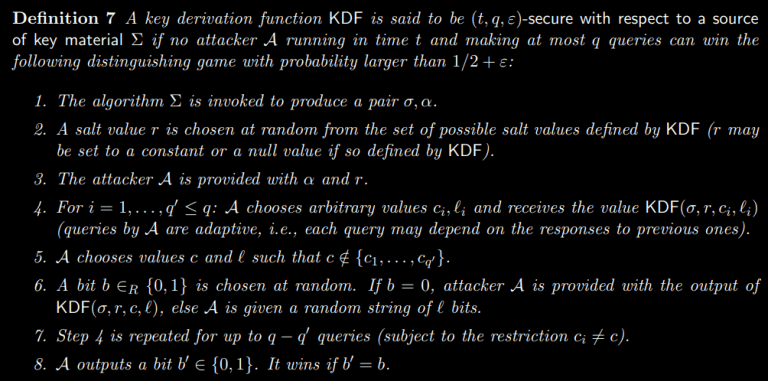Search
Items tagged with: cryptographicHashFunction
Ever since the famous “Open Sesame” line from One Thousand and One Nights, humanity was doomed to suffer from the scourge of passwords.
Even in a world where we use hardware tokens with asymmetric cryptography to obviate the need for passwords in modern authentication protocols, we’ll still need to include “something you know” for legal and political reasons.
In the United States, we have the Fifth Amendment to the US Constitution, which prevents anyone from being forced to testify against oneself. This sometimes includes revealing a password, so it is imperative that passwords remain a necessary component of some encryption technologies to prevent prosecutors from side-stepping one’s Fifth Amendment rights. (Other countries have different laws about passwords. I’m not a lawyer.)
If you’ve ever read anything from the EFF, you’re probably keenly aware of this, but the US government loves to side-step citizens’ privacy rights in a court of law. They do this not out of direct malice towards civil rights (generally), but rather because it makes their job easier. Incentives rule everything around me.
Thus, even in a passwordless future, anyone who truly cares about civil liberties will not want to dispense with them entirely. Furthermore, we’ll want these password-based technologies to pass the Mud Puddle test, so that we aren’t relying on large tech companies to protect us from government backdoors.
Given all this, most security professionals will agree that passwords suck. Not only are humans bad sources of randomness, but we’re awful at memorizing a sequence of characters or words for every application, website, or operating system that demands a password.
None of what I’ve written so far is the least bit novel or interesting. But here’s a spicy take:
The only thing that sucks worse than passwords is the messaging around password-based cryptographic functions.
Password-Based Cryptographic Functions
That isn’t a term of the art, by the way. I’m kind of coining it as a superset that includes both Password-Based Key Derivation Functions and Password Hashing Functions.
You might be wondering, “Aren’t those two the same thing?” No, they are not. I will explain in a moment.
The intersection of human-memorable secrets (passwords) and cryptographic protocols manifests in a lot of needless complexity and edge-cases that, in order to sufficiently explain anything conversationally, will require me to sound either drunk or like a blue deck player in Magic: The Gathering.

Art: CMYKat
To that end, what I’m calling Password-Based Cryptographic Functions (PBCFs) includes all of the following:
- Password-Hashing Functions
- Bcrypt
- Password-Based Key Derivation Functions
- Scrypt
- Argon2
- PBKDF2
- bscrypt
- Balanced Password Authenticated Key Exchanges
- CPace
- Augmented Password Authenticated Key Exchanges
- SRP
- AuCPace
- BS-SPEKE
- Doubly-Augmented Password Authenticated Key Exchanges
- OPAQUE
- Double BS-SPEKE
If you tried to approach categorization starting with simply “Key Derivation Functions”, you’d quickly run into a problem: What about HKDF? Or any of the NIST SP 800-108 KDFs for that matter?
If you tighten it to “Password-Based KDFs” or “Key-stretching functions”, that doesn’t include bcrypt. Bcrypt is a password hashing function, but it’s not suitable for deriving secret keys. I’ve discussed these nuances previously.
And then you have some password KDF and/or hashing algorithms that are memory-hard, some that are cache-hard.
And then some Password Authenticated Key Exchanges (PAKEs) are quantum-annoying, while others are not.

To make heads or tails of the different algorithms, their properties, and when and where you should use them, you’d either need to secure postdoc funding for cryptography research or spend a lot of time reading and watching passwords-focused conference talks.

(Selfie taken by Sc00bz (left) at DEFCON 30 in the Quantum Village.)
So let’s talk about these different algorithms, why they exist to begin with, and some of their technical details.

Why Does Any of This Matter?
The intersection of passwords and cryptography is one of the foundations of modern society, and one that most Internet users experience everywhere they go.
You’ll know you have succeeded in designing a cryptographic algorithm when the best way to attack it is to try every possible key. This is called an exhaustive search, or a brute-force attack, depending on the disposition of the author.
Remember earlier when I said passwords suck because humans are bad at creating or remembering strong, unique passwords for every website they visit?
Well, it turns out, that some passwords are extremely common. And even worse, people who choose common passwords tend to reuse them everywhere.
This presented a challenge to early web applications: In order to have authenticated users, you need to collect a password from the user and check it on subsequent visits. If you ever get hacked, then it’s likely that all of your users will be impacted on other websites they used the same passwords for.
Including their bank accounts.
So the challenge for any password-based scheme is simply stated: How can you safely authenticate users based on a secret they know?
Enter: Hashing
Storing a hash of a password is an obvious solution to this predicament. Early solutions involved using the user’s password as an encryption key, rather than building atop cryptographic hash functions.
However, it’s important not to call it “password encryption”.
The reason isn’t merely pedantic; it’s meant to prevent a disaster from repeating: Adobe famously encrypted passwords with Triple-DES instead of hashing them.
In early UNIX-based operating systems, your password hashes were stored in a file called /etc/passwd, along with other user account data. These days, your actual password hashes are kept in a second file, /etc/shadow, which is only readable by root.
Unfortunately, the tool used to create password hashes was called crypt, so the “encryption” lingo stuck.

When Hashing Isn’t Enough
Although encrypting passwords is bad, using a fast cryptographic hash function (e.g. SHA256 or BLAKE2) is also bad.
LinkedIn learned this lesson the hard way in 2012, when an attacker leaked 117 million users’ hashed passwords. It turns out, they used SHA1 as their password hashing function.
Hash functions are deterministic: If you feed them the same input, you will always get the same output.
When your password hashing strategy is simply “just use SHA1”, two users with the same password will have an identical password hash.
People are bad at creating, or remembering, unpredictable passwords.
When you combine these observations, there are some extremely obvious candidates (123456, password, etc.) to prioritize when guessing.
Additionally, you could precompute these hashes once and build a reverse index of the passwords that hash to a specific output. This is called a rainbow table.
Unlike most of symmetric cryptography, where the goal ends at forcing the attacker to perform an exhaustive brute-force search of every possible key, password-based cryptography has to go the extra mile to prevent weak secrets from being compromised; a very tall order for anyone to contend with.
Towards Modern Password Hashing
None of this was a surprise to security experts in 2012. There were a couple generally known best practices since I first learned programming in the 2000s:
- Salt your passwords (to mitigate rainbow tables)
- Use an iterated hashing scheme, rather than a fast hash (to make each step of an exhaustive search slower)
PBKDF2, the first widely used password hashing and key derivation function, did exactly that:
- PBKDF2 was designed to support randomly-generated per-user salts.
- It used HMAC in a loop to force attackers to spend extra CPU cycles per guess. If an attacker could guess 10 million passwords per second against SHA-256, then using 100,000 iterations of PBKDF2 slowed them down to less than 100 guesses per second (due to HMAC calling the hash function twice).
And that might sound like the end of the story (“PBKDF2 wins”), but the password cracking community is extremely clever, so it’s only just begun.
Parallel Attacks and GPUs
Since your CPU can only guess a few hashes per second, PBKDF2 is a thorny problem to contend with.
However, there’s an easy way for attackers to use commodity hardware to bypass this limitation: Graphics cards are specially designed to perform a lot of low-memory calculations in parallel.
If you can write your password cracking code to leverage the benefits of GPUs instead of CPUs, then PBKDF2 becomes easy potatoes.
The other secure password hashing algorithm in use at the time, bcrypt, had only a linear improvement over PBKDF2’s security against GPU attacks.
Memory-Hard Password Hashing Algorithms
In 2009, Colin Percival proposed scrypt to mitigate this risk. Scrypt (pronounced “ess crypt”) builds atop PBKDF2-SHA256 by hashing psuedorandom regions of memory with Salsa20/8 (hence the S in Scrypt) in a way that makes it difficult to precompute.
Scrypt hashes require large amounts of memory to compute (at least 16 megabytes, in the recommended minimum configuration, versus the few kilobytes of incumbent password hashes).
While GPUs (and FPGAs, and ASICs, and …) are great for cracking password hashes that use CPU-bounded algorithms, algorithms that access large amounts of memory are difficult to attack effectively.
It’s still possible for clever programmers to work around this memory/bandwidth limitation, but to do so, you must compute more operations, which makes it not worthwhile.
Cryptographers and the password-cracking community call this expensive time-memory trade-off memory hardness. In 2016, it was determined that scrypt is maximally memory-hard.
Password Hashing Competition
The Password Hashing Competition (PHC) was kicked off by JP Aumasson in 2012 to develop a new standard for password hashing and password-based key derivation.
In 2015, they selected Argon2 as its recommendation, with four finalists receiving special recognition (Catena, Lyra2, Makwa, and yescrypt–which is based on scrypt).
Cache-Hardness
In the years since the PHC concluded, the advances in password cracking techniques have not slowed down.
One of the PHC judges recently proposed a new algorithm called bscrypt which purports a property called “cache hard” rather than “memory hard”. The reasoning is that, for shorter run times, memory bandwidth and small CPU caches is a tighter bottleneck than overall memory requirements.
In fact, there’s an Argon2 variant (Argon2ds) which offers cache-hardness.
Two Hard Choices
So which of the two should you care about, as a defender?
If you’re validating password hashes in an online service, a cache-hard algorithm might make more sense. You’re incentivized to have shorter server-side run times to avoid DoS attacks, so the benefits of cache-hardness seem more impactful than memory-hardness.
If you’re deriving a sensitive cryptography key from a password and can afford to take several seconds of wall-clock time, a memory-hard algorithm is likely to be a better fit for your threat model.
(Or, like, run both a cache-hard and memory-hard algorithm and use a fast KDF, such as HKDF, to mix the two into your final cryptography key.)
Of course, the story doesn’t end here. Password Hashing and Password-Based Key Derivation continues to mature as the password cracking community discovers new attacks and engineers defenses against them.

A Strange Game; The Only Winning Move is to PAKE
Password hashing is a defense-in-depth against a system compromise that enables attackers to perform offline attacks against a cryptographic output to determine a user’s password.
However, for many applications, the bigger question is, “Why even play this game in the first place?”
Password-Authenticated Key Exchanges
A password authenticated key exchange (PAKE) algorithm is an interactive protocol to establish keys based on at least one party’s knowledge of a password.
PAKEs are what enable you to log into encrypted WiFi connections and encrypt your traffic. PAKEs prevent you from having to reveal the password (or a password-equivalent value, such as a password hash) to the other party.
Although there are a lot of proposed PAKE algorithms, the one that most people implemented was SRP (“Secure Remote Password”), which was intuitively a lot like Diffie-Hellman but also not Diffie-Hellman (since SRP used addition).
For a good teardown on SRP, Matthew Green’s blog is highly recommended.
There are a few real-world cryptography problems with using SRP:
- You need to use a special kind of prime number for your protocol. The standard Diffie-Hellman moduli are not suitable for SRP; you want a safe prime (i.e. a number of the form N = 2q + 1, where q is also prime).
- One of the steps in SRP, client-side, is to compute
A = g^a (mod N). Here,Ais a public value whileais a secret (usually the SHA1 hash of the username and pasword).
If your software implementation of modular exponentiation (a^x mod P) isn’t constant-time, you leaka, which is a password-equivalent value.
Additionally, it’s not possible to use SRP with elliptic curve groups. (Matthew Green’s post I linked above covers this in detail!)
Thus, SRP is generally considered to be deprecated by security experts, in favor of other PAKEs.
IETF, CFRG, PAKE Selection
As early as IETF 104, the Crypto Forum Research Group (CFRG) began exploring different PAKE algorithms to select for standardization.
One of the motivators for this work is that the WiFi alliance had shoehorned a new PAKE called Dragonfly into their WPA3, which turned out to be badly designed.
The CFRG’s candidate algorithms and reviews were publicly tracked on GitHub, if you’re curious.
TL;DR – They settled on recommending OPAQUE as an augmented PAKE and CPace as a balanced PAKE.
Sc00bz has done multiple talks at security conferences over the years to talk about PAKEs:
https://www.youtube.com/watch?v=28SM5ILpHEE
Quantum Annoyance
The PAKEs we’ve discussed involved a cyclic group (and the newer ones involved an elliptic curve group). The security of these schemes is dependent on the hardness of a discrete logarithm problem.
If a cryptography relevant quantum computer (CRQC) is developed, discrete logarithm problems will cease to be hard.
Some PAKEs fall apart the moment a discrete log is solvable. This is par for the course for Diffie-Hellman and elliptic curve cryptography.
Others require an attacker to solve a discrete log for every guess in an offline attack (after capturing a successful exchange). This makes them annoying for quantum attackers.
While they don’t provide absolute security like post-quantum cryptography, they do make attackers armed with a CRQC work harder.
OPAQUE isn’t quantum annoying. Simply observe all of the packets from making an online guess, solve the DLP offline, and you’re back to the realm of classical offline guessing.

The State of the Art
At this point, you may feel somewhat overwhelmed by all of this information. It’s very tempting to simplify all of this historical context and technical detail.
You might be telling yourself, “Okay, Scrypt, Argon2, CPace, OPAQUE. Got it. That’s all I need to remember. Everything else is questionable at best. Ask a cryptographer. I’m bailing out, yo!”
But the story gets worse on two fronts: Real-world operational requirements, and compliance.
Your Hands Are Tied, Now Swim
If you’re selling a product or service to the US government that uses cryptography, you need to first clear a bare minimum bar called FIPS 140.
FIPS 140 is opinionated about which algorithms you use. For password hashing and password-based key derivation, FIPS defers to NIST SP 800-209, which means you’re only permitted to use PBKDF2 in any FIPS modules (with a SHA2- family hash function). (Update: See below.)
So all of the information about memory-hard and cache-hard password hashing algorithms? This is useless for you if you ever try to sell to the US government.
An open question is whether Scrypt is FIPSable due to it building atop PBKDF2. To be blunt: I’m not sure. Ask a NIST Cryptographic Module Validation Program lab for their opinion.
Update (2022-01-07): A Brief Correction
Thanks to FreakLegion for pointing this out.
According to NIST SP 800-63B, memory-hard hash functions are recommended.
Examples of suitable key derivation functions include Password-based Key Derivation Function 2 (PBKDF2) [SP 800-132] and Balloon [BALLOON]. A memory-hard function SHOULD be used because it increases the cost of an attack.NIST SP 800-63B
Don’t use Balloon, though. It’s under-specified.
FreakLegion indicates in their Hacker News comment that scrypt and yescrypt are both acceptable.
End Update
In the realm of PAKEs, both CPace and OPAQUE are frameworks that can be used with multiple elliptic curve groups.
Both frameworks support NIST P-256, but CPace supports X25519 and OPAQUE supports Ristretto255; these are currently not FIPSable curves.
“I don’t care about FIPS. Argon2 all the things!”
JavaScript runtimes don’t provide a built-in Argon2 implementation. This poses several challenges.
- Do you care about iOS users? Lockdown mode prevents you from using WebAssembly, even in a browser extension.
- Trying to polyfill scrypt or Argon2 in a scripting language is a miserable experience. We’re talking quadratic performance penalties here. Several minutes of CPU time to calculate a hash that is far too weak to be acceptable in any context.
Consequently, not a single password manager I’ve evaluated that provides a browser extension uses a memory-hard algorithm for deriving encryption keys.
Update: I’ve been told Dashlane uses Argon2.

This Is Frustrating
When I write about cryptography, my goal is always to be clear, concise, and helpful. I want whoever reads my writing to, regardless of their level of expertise, walk away more comfortable with the subject matter.
At minimum, I want you to be able to intuit when you need to ask an expert for help, and have a slightly better understanding of how to word your questions to get the answer you need. In an ideal world, you’d even be able to spot the same kind of weaknesses I do in cryptography designs and implementations after reading enough of this blog.
I can’t do that with password-based cryptography. The use-cases and threat models are too varied to make a clear-cut recommendation, and it’s too complicated to parcel out in a way that doesn’t feel reductive or slightly contradictory. This leads to too many caveats or corner cases.
Passwords suck.
If you ask a password cracking expert and describe your use case, you’ll likely get an opinionated and definitive answer. But every time I’ve asked generally about this subject, without a specific use case in mind, I got an opinionated answer followed by a long chain of caveats and alternatives.
With that in mind, here’s a few vague guidelines that are up-to-date as of the end of 2022.

Recommendations for Password-Based Cryptography in 2023
Password Hashing
If you’re authenticating users in an online service (storing the hashes in a database), use any of the following algorithms:
- bcrypt with a cost factor appropriate to take about 100 milliseconds to compute on your server hardware (typically at least 12)
- scrypt with N = 32768, r = 8, p = 1 and a random salt at least 128 bits in length (256 preferred)
- Argon2id with a memory cost of 64 MiB, ops cost of 3, and parallelism of 1
If you’re forced to use PBKDF2 for whatever dumb reason, the parameters you want are at least:
- SHA-512 with 210,000 rounds (preferred)
- SHA-256 with 600,000 rounds
- SHA-1 (if you must) with 1,300,000 rounds
These numbers are based on constraining attackers to less than 10,000 hashes per second, per GPU.
I’m not currently recommending any algorithms deliberately designed for cache-hardness because they need further analysis from other cryptographers. (Bcrypt is minimally cache-hard, but that wasn’t a stated design goal.)
I didn’t evaluate the other PHC finalists nor other designs (Balloon hashing, Ball and Chain, etc.). Ask your cryptographer if those are appropriate instead.
Password-Based Key Derivation
If you’re deriving an encryption key from a password, use any of the following algorithms:
- scrypt with N = 1048576, r = 8, p = 1 and a random salt at least 128 bits in length (256 preferred)
- Argon2id with a memory cost of 1024 MiB, ops cost of 4, and parallelism of 1
If you’re forced to use PBKDF2 for whatever dumb reason, the parameters you want should target between 1 and 10 seconds on the defender’s hardware. If this is somehow slower than the numbers given for password hashing above, go with the password hashing benchmarks instead.
Here’s a dumb PHP script you can use to quickly find some target numbers.
<?php/* Dumb PBKDF2 benchmarking script by Soatok. 2022-12-29 */$salt = random_bytes(32);$password = 'correct horse battery staple';$c = '';$start = $end = microtime(true);foreach(['sha1', 'sha256', 'sha512'] as $alg) {foreach ([1 << 14,1 << 15,1 << 16,1 << 17,1 << 18,1 << 19,1 << 20,1200000,1 << 21,2500000,3000000,3500000,1 << 22,5000000,1 << 23,1 << 24,1 << 25,] as $n) { $start = microtime(true); $c ^= hash_pbkdf2($alg, $password, $salt, $n, 32, true); $end = microtime(true); $time = $end - $start; echo str_pad($n, 12, ' ', STR_PAD_LEFT), " iterations ({$alg}) -> \t", $time, PHP_EOL; if ($time > 5.5) { echo PHP_EOL; break; }}}
On my laptop, targeting 5.0 seconds means at least 4,000,000 rounds of PBKDF2 with SHA1, SHA256, or SHA512 (with SHA256 coming closer to 5,000,000).
If you’re aiming for less than 1,000 hashes per second per GPU, against an attacker armed with an RTX 4090:
- SHA-512 with 3,120,900 iterations (preferred)
- SHA256 with 8,900,000 iterations
- SHA-1 with 20,000,000 iterations
Sc00bz tells me that this generation of GPU has better performance/cost than previous generations (which had seen diminishing returns), but requires 1.5x the power, 1.78x the price, and 2x the physical space. Sc00bz refers to this as “1.5 GPUs”.
If you adjust for these factors, your final PBKDF2 target becomes:
- SHA-512 with 2,100,000 iterations (preferred)
- SHA-256 with 6,000,000 iterations
- SHA-1 with 13,000,000 iterations
Password Authenticated Key Exchanges
In a client-server model, where the server isn’t meant to see password-equivalent data, you want an augmented PAKE (or perhaps a doubly-augmented PAKE).
You’re overwhelmingly more likely to find OPAQUE support in the immediate future, due to the direction the IETF CFRG is moving today.
In a more peer-to-peer model, you want a balanced PAKE. CPace is the best game in town.
Don’t use SRP if you can help it.
If you can’t help it, make sure you use one of the groups defined in RFC 5054, rather than a generic Diffie-Hellman group. You’ll also want an expert to review your implementation to make sure your BigInt library isn’t leaking your users’ private exponents.
Also, feel free to deviate from SHA1 for calculating the private exponent from their username and password. SHA1 sucks. Nothing is stopping you from using a password KDF (or, at worst, SHA256) here, as long as you do so consistently.
(But as always, ask your cryptography expert first.)

TL;DR
Password-Based Cryptography is a mess.
If you’re not aware of the history of the field and the technical details that went into the various cryptographic algorithms that experts recommend today, it’s very easy to say something wrong that sounds correct to an untrained ear.
At the end of the day, the biggest risk you face with password-based cryptography is not using a suitable algorithm in the first place, rather than using a less optimal algorithm.
Experts have good reasons to hate PBDKF2 (slow for defenders, fast for attackers) and SRP (we have better options today, which also come with actual security proofs), but they certainly hate unsalted SHA1 and Triple-DES more.
My only real contribution to this topic is an effort to make it easier to talk about to non-experts by offering a new term for the superset of all of these password-based algorithms: Password-Based Cryptographic Functions.
Finally, the password cracking community is great. There are a lot of smart and friendly people involved, and they’re all working to make this problem easier to get right. If you’re not sure where to start, check out PasswordsCon.

https://soatok.blog/2022/12/29/what-we-do-in-the-etc-shadow-cryptography-with-passwords/
#cryptographicHashFunction #cryptographicProtocols #OPAQUE #passwordHashing #PBKDF2 #SecureRemotePasswordProtocol #SecurityGuidance
NIST opened public comments on SP 800-108 Rev. 1 (the NIST recommendations for Key Derivation Functions) last month. The main thing that’s changed from the original document published in 2009 is the inclusion of the Keccak-based KMAC alongside the incumbent algorithms.One of the recommendations of SP 800-108 is called “KDF in Counter Mode”. A related document, SP 800-56C, suggests using a specific algorithm called HKDF instead of the generic Counter Mode construction from SP 800-108–even though they both accomplish the same goal.
Isn’t standards compliance fun?
Interestingly, HKDF isn’t just an inconsistently NIST-recommended KDF, it’s also a common building block in a software developer’s toolkit which sees a lot of use in different protocols.
Unfortunately, the way HKDF is widely used is actually incorrect given its formal security definition. I’ll explain what I mean in a moment.
Art: Scruff
What is HKDF?
To first understand what HKDF is, you first need to know about HMAC.HMAC is a standard message authentication code (MAC) algorithm built with cryptographic hash functions (that’s the H). HMAC is specified in RFC 2104 (yes, it’s that old).
HKDF is a key-derivation function that uses HMAC under-the-hood. HKDF is commonly used in encryption tools (Signal, age). HKDF is specified in RFC 5869.
HKDF is used to derive a uniformly-random secret key, typically for use with symmetric cryptography algorithms. In any situation where a key might need to be derived, you might see HKDF being used. (Although, there may be better algorithms.)
Art: LvJ
How Developers Understand and Use HKDF
If you’re a software developer working with cryptography, you’ve probably seen an API in the crypto module for your programming language that looks like this, or maybe this.hash_hkdf( string $algo, string $key, int $length = 0, string $info = "", string $salt = ""): string
Software developers that work with cryptography will typically think of the HKDF parameters like so:
$algo— which hash function to use$key— the input key, from which multiple keys can be derived$length— how many bytes to derive$info— some arbitrary string used to bind a derived key to an intended context$salt— some additional randomness (optional)The most common use-case of HKDF is to implement key-splitting, where a single input key (the Initial Keying Material, or IKM) is used to derive two or more independent keys, so that you’re never using a single key for multiple algorithms.
See also:
[url=https://github.com/defuse/php-encryption]defuse/php-encryption[/url], a popular PHP encryption library that does exactly what I just described.At a super high level, the HKDF usage I’m describing looks like this:
class MyEncryptor {protected function splitKeys(CryptographyKey $key, string $salt): array { $encryptKey = new CryptographyKey(hash_hkdf( 'sha256', $key->getRawBytes(), 32, 'encryption', $salt )); $authKey = new CryptographyKey(hash_hkdf( 'sha256', $key->getRawBytes(), 32, 'message authentication', $salt )); return [$encryptKey, $authKey];}public function encryptString(string $plaintext, CryptographyKey $key): string{ $salt = random_bytes(32); [$encryptKey, $hmacKey] = $this->splitKeys($key, $salt); // ... encryption logic here ... return base64_encode($salt . $ciphertext . $mac);}public function decryptString(string $encrypted, CryptographyKey $key): string{ $decoded = base64_decode($encrypted); $salt = mb_substr($decoded, 0, 32, '8bit'); [$encryptKey, $hmacKey] = $this->splitKeys($key, $salt); // ... decryption logic here ... return $plaintext;}// ... other method here ...}
Unfortunately, anyone who ever does something like this just violated one of the core assumptions of the HKDF security definition and no longer gets to claim “KDF security” for their construction. Instead, your protocol merely gets to claim “PRF security”.
Art: Harubaki
KDF? PRF? OMGWTFBBQ?
Let’s take a step back and look at some basic concepts.(If you want a more formal treatment, read this Stack Exchange answer.)
PRF: Pseudo-Random Functions
A pseudorandom function (PRF) is an efficient function that emulates a random oracle.“What the hell’s a random oracle?” you ask? Well, Thomas Pornin has the best explanation for random oracles:
A random oracle is described by the following model:
- There is a black box. In the box lives a gnome, with a big book and some dice.
- We can input some data into the box (an arbitrary sequence of bits).
- Given some input that he did not see beforehand, the gnome uses his dice to generate a new output, uniformly and randomly, in some conventional space (the space of oracle outputs). The gnome also writes down the input and the newly generated output in his book.
- If given an already seen input, the gnome uses his book to recover the output he returned the last time, and returns it again.
So a random oracle is like a kind of hash function, such that we know nothing about the output we could get for a given input message m. This is a useful tool for security proofs because they allow to express the attack effort in terms of number of invocations to the oracle.
The problem with random oracles is that it turns out to be very difficult to build a really “random” oracle. First, there is no proof that a random oracle can really exist without using a gnome. Then, we can look at what we have as candidates: hash functions. A secure hash function is meant to be resilient to collisions, preimages and second preimages. These properties do not imply that the function is a random oracle.
Thomas Pornin
Alternatively, Wikipedia has a more formal definition available to the academic-inclined.In practical terms, we can generate a strong PRF out of secure cryptographic hash functions by using a keyed construction; i.e. HMAC.
Thus, as long as your HMAC key is a secret, the output of HMAC can be generally treated as a PRF for all practical purposes. Your main security consideration (besides key management) is the collision risk if you truncate its output.
Art: LvJ
KDF: Key Derivation Functions
A key derivation function (KDF) is exactly what it says on the label: a cryptographic algorithm that derives one or more cryptographic keys from a secret input (which may be another cryptography key, a group element from a Diffie-Hellman key exchange, or a human-memorable password).Note that passwords should be used with a Password-Based Key Derivation Function, such as scrypt or Argon2id, not HKDF.
Despite what you may read online, KDFs do not need to be built upon cryptographic hash functions, specifically; but in practice, they often are.
A notable counter-example to this hash function assumption: CMAC in Counter Mode (from NIST SP 800-108) uses AES-CMAC, which is a variable-length input variant of CBC-MAC. CBC-MAC uses a block cipher, not a hash function.
Regardless of the construction, KDFs use a PRF under the hood, and the output of a KDF is supposed to be a uniformly random bit string.
Art: LvJ
PRF vs KDF Security Definitions
The security definition for a KDF has more relaxed requirements than PRFs: PRFs require the secret key be uniformly random. KDFs do not have this requirement.If you use a KDF with a non-uniformly random IKM, you probably need the KDF security definition.
If your IKM is already uniformly random (i.e. the “key separation” use case), you can get by with just a PRF security definition.
After all, the entire point of KDFs is to allow a congruent security level as you’d get from uniformly random secret keys, without also requiring them.
However, if you’re building a protocol with a security requirement satisfied by a KDF, but you actually implemented a PRF (i.e., not a KDF), this is a security vulnerability in your cryptographic design.
Art: LvJ
The HKDF Algorithm
HKDF is an HMAC-based KDF. Its algorithm consists of two distinct steps:
HKDF-Extractuses the Initial Keying Material (IKM) and Salt to produce a Pseudo-Random Key (PRK).HKDF-Expandactually derives the keys using PRK, theinfoparameter, and a counter (from0to255) for each hash function output needed to generate the desired output length.If you’d like to see an implementation of this algorithm,
defuse/php-encryptionprovides one (since it didn’t land in PHP until 7.1.0). Alternatively, there’s a Python implementation on Wikipedia that uses HMAC-SHA256.This detail about the two steps will matter a lot in just a moment.
Art: Swizz
How HKDF Salts Are Misused
The HKDF paper, written by Hugo Krawczyk, contains the following definition (page 7).
The paper goes on to discuss the requirements for authenticating the salt over the communication channel, lest the attacker have the ability to influence it.
A subtle detail of this definition is that the security definition says that A salt value
, not Multiple salt values.
Which means: You’re not supposed to use HKDF with a constant IKM, info label, etc. but vary the salt for multiple invocations. The salt must either be a fixed random value, or NULL.
The HKDF RFC makes this distinction even less clear when it argues for random salts.
We stress, however, that the use of salt adds significantly to the strength of HKDF, ensuring independence between different uses of the hash function, supporting “source-independent” extraction, and strengthening the analytical results that back the HKDF design.Random salt differs fundamentally from the initial keying material in two ways: it is non-secret and can be re-used. As such, salt values are available to many applications. For example, a pseudorandom number generator (PRNG) that continuously produces outputs by applying HKDF to renewable pools of entropy (e.g., sampled system events) can fix a salt value and use it for multiple applications of HKDF without having to protect the secrecy of the salt. In a different application domain, a key agreement protocol deriving cryptographic keys from a Diffie-Hellman exchange can derive a salt value from public nonces exchanged and authenticated between communicating parties as part of the key agreement (this is the approach taken in [IKEv2]).
RFC 5869, section 3.1
Okay, sure. Random salts are better than a NULL salt. And while this section alludes to “[fixing] a salt value” to “use it for multiple applications of HKDF without having to protect the secrecy of the salt”, it never explicitly states this requirement. Thus, the poor implementor is left to figure this out on their own.Thus, because it’s not using HKDF in accordance with its security definition, many implementations (such as the PHP encryption library we’ve been studying) do not get to claim that their construction has KDF security.
Instead, they only get to claim “Strong PRF” security, which you can get from just using HMAC.
Art: LvJ
What Purpose Do HKDF Salts Actually Serve?
Recall that the HKDF algorithm uses salts in the HDKF-Extract step. Salts in this context were intended for deriving keys from a Diffie-Hellman output, or a human-memorable password.In the case of [Elliptic Curve] Diffie-Hellman outputs, the result of the key exchange algorithm is a random group element, but not necessarily uniformly random bit string. There’s some structure to the output of these functions. This is why you always, at minimum, apply a cryptographic hash function to the output of [EC]DH before using it as a symmetric key.
HKDF uses salts as a mechanism to improve the quality of randomness when working with group elements and passwords.
Extending the nonce for a symmetric-key AEAD mode is a good idea, but using HKDF’s salt parameter specifically to accomplish this is a misuse of its intended function, and produces a weaker argument for your protocol’s security than would otherwise be possible.
How Should You Introduce Randomness into HKDF?
Just shove it in theinfoparameter.
Art: LvJ
It may seem weird, and defy intuition, but the correct way to introduce randomness into HKDF as most developers interact with the algorithm is to skip the salt parameter entirely (either fixing it to a specific value for domain-separation or leaving it NULL), and instead concatenate data into the
infoparameter.class BetterEncryptor extends MyEncryptor {protected function splitKeys(CryptographyKey $key, string $salt): array { $encryptKey = new CryptographyKey(hash_hkdf( 'sha256', $key->getRawBytes(), 32, $salt . 'encryption', '' // intentionally empty )); $authKey = new CryptographyKey(hash_hkdf( 'sha256', $key->getRawBytes(), 32, $salt . 'message authentication', '' // intentionally empty )); return [$encryptKey, $authKey];}}
Of course, you still have to watch out for canonicalization attacks if you’re feeding multi-part messages into the info tag.
Another advantage: This also lets you optimize your HKDF calls by caching the PRK from the
HKDF-Extractstep and reuse it for multiple invocations ofHKDF-Expandwith a distinctinfo. This allows you to reduce the number of hash function invocations fromto
(since each HMAC involves two hash function invocations).
Notably, this HKDF salt usage was one of the things that was changed in V3/V4 of PASETO.
Does This Distinction Really Matter?
If it matters, your cryptographer will tell you it matters–which probably means they have a security proof that assumes the KDF security definition for a very good reason, and you’re not allowed to violate that assumption.Otherwise, probably not. Strong PRF security is still pretty damn good for most threat models.
Art: LvJ
Closing Thoughts
If your takeaway was, “Wow, I feel stupid,” don’t, because you’re in good company.I’ve encountered several designs in my professional life that shoved the randomness into the
infoparameter, and it perplexed me because there was a perfectly good salt parameter right there. It turned out, I was wrong to believe that, for all of the subtle and previously poorly documented reasons discussed above. But now we both know, and we’re all better off for it.So don’t feel dumb for not knowing. I didn’t either, until this was pointed out to me by a very patient colleague.
“Feeling like you were stupid” just means you learned.
(Art: LvJ)Also, someone should really get NIST to be consistent about whether you should use HKDF or “KDF in Counter Mode with HMAC” as a PRF, because SP 800-108’s new revision doesn’t concede this point at all (presumably a relic from the 2009 draft).
This concession was made separately in 2011 with SP 800-56C revision 1 (presumably in response to criticism from the 2010 HKDF paper), and the present inconsistency is somewhat vexing.
(On that note, does anyone actually use the NIST 800-108 KDFs instead of HKDF? If so, why? Please don’t say you need CMAC…)
Bonus Content
These questions were asked after this blog post initially went public, and I thought they were worth adding. If you ask a good question, it may end up being edited in at the end, too.
Art: LvJ
Why Does HKDF use the Salt as the HMAC key in the Extract Step? (via r/crypto)
Broadly speaking, when applying a PRF to two “keys”, you get to decide which one you treat as the “key” in the underlying API.HMAC’s API is HMACalg(key, message), but how HKDF uses it might as well be HMACalg(key1, key2).
The difference here seems almost arbitrary, but there’s a catch.
HKDF was designed for Diffie-Hellman outputs (before ECDH was the norm), which are generally able to be much larger than the block size of the underlying hash function. 2048-bit DH results fit in 256 bytes, which is 4 times the SHA256 block size.
If you have to make a decision, using the longer input (DH output) as the message is more intuitive for analysis than using it as the key, due to pre-hashing. I’ve discussed the counter-intuitive nature of HMAC’s pre-hashing behavior at length in this post, if you’re interested.
So with ECDH, it literally doesn’t matter which one was used (unless you have a weird mismatch in hash functions and ECC groups; i.e. NIST P-521 with SHA-224).
But before the era of ECDH, it was important to use the salt as the HMAC key in the extract step, since they were necessarily smaller than a DH group element.
Thus, HKDF chose HMACalg(salt, IKM) instead of HMACalg(IKM, salt) for the calculation of PRK in the HKDF-Extract step.
Neil Madden also adds that the reverse would create a chicken-egg situation, but I personally suspect that the pre-hashing would be more harmful to the security analysis than merely supplying a non-uniformly random bit string as an HMAC key in this specific context.
My reason for believing this is, when a salt isn’t supplied, it defaults to a string of
0x00bytes as long as the output size of the underlying hash function. If the uniform randomness of the salt mattered that much, this wouldn’t be a tolerable condition.https://soatok.blog/2021/11/17/understanding-hkdf/
#cryptographicHashFunction #cryptography #hashFunction #HMAC #KDF #keyDerivationFunction #securityDefinition #SecurityGuidance

NIST opened public comments on SP 800-108 Rev. 1 (the NIST recommendations for Key Derivation Functions) last month. The main thing that’s changed from the original document published in 2009 is the inclusion of the Keccak-based KMAC alongside the incumbent algorithms.
One of the recommendations of SP 800-108 is called “KDF in Counter Mode”. A related document, SP 800-56C, suggests using a specific algorithm called HKDF instead of the generic Counter Mode construction from SP 800-108–even though they both accomplish the same goal.
Isn’t standards compliance fun?
Interestingly, HKDF isn’t just an inconsistently NIST-recommended KDF, it’s also a common building block in a software developer’s toolkit which sees a lot of use in different protocols.
Unfortunately, the way HKDF is widely used is actually incorrect given its formal security definition. I’ll explain what I mean in a moment.

What is HKDF?
To first understand what HKDF is, you first need to know about HMAC.
HMAC is a standard message authentication code (MAC) algorithm built with cryptographic hash functions (that’s the H). HMAC is specified in RFC 2104 (yes, it’s that old).
HKDF is a key-derivation function that uses HMAC under-the-hood. HKDF is commonly used in encryption tools (Signal, age). HKDF is specified in RFC 5869.
HKDF is used to derive a uniformly-random secret key, typically for use with symmetric cryptography algorithms. In any situation where a key might need to be derived, you might see HKDF being used. (Although, there may be better algorithms.)

How Developers Understand and Use HKDF
If you’re a software developer working with cryptography, you’ve probably seen an API in the crypto module for your programming language that looks like this, or maybe this.
hash_hkdf( string $algo, string $key, int $length = 0, string $info = "", string $salt = ""): string
Software developers that work with cryptography will typically think of the HKDF parameters like so:
$algo— which hash function to use$key— the input key, from which multiple keys can be derived$length— how many bytes to derive$info— some arbitrary string used to bind a derived key to an intended context$salt— some additional randomness (optional)
The most common use-case of HKDF is to implement key-splitting, where a single input key (the Initial Keying Material, or IKM) is used to derive two or more independent keys, so that you’re never using a single key for multiple algorithms.
See also: [url=https://github.com/defuse/php-encryption]defuse/php-encryption[/url], a popular PHP encryption library that does exactly what I just described.
At a super high level, the HKDF usage I’m describing looks like this:
class MyEncryptor {protected function splitKeys(CryptographyKey $key, string $salt): array { $encryptKey = new CryptographyKey(hash_hkdf( 'sha256', $key->getRawBytes(), 32, 'encryption', $salt )); $authKey = new CryptographyKey(hash_hkdf( 'sha256', $key->getRawBytes(), 32, 'message authentication', $salt )); return [$encryptKey, $authKey];}public function encryptString(string $plaintext, CryptographyKey $key): string{ $salt = random_bytes(32); [$encryptKey, $hmacKey] = $this->splitKeys($key, $salt); // ... encryption logic here ... return base64_encode($salt . $ciphertext . $mac);}public function decryptString(string $encrypted, CryptographyKey $key): string{ $decoded = base64_decode($encrypted); $salt = mb_substr($decoded, 0, 32, '8bit'); [$encryptKey, $hmacKey] = $this->splitKeys($key, $salt); // ... decryption logic here ... return $plaintext;}// ... other method here ...}
Unfortunately, anyone who ever does something like this just violated one of the core assumptions of the HKDF security definition and no longer gets to claim “KDF security” for their construction. Instead, your protocol merely gets to claim “PRF security”.

KDF? PRF? OMGWTFBBQ?
Let’s take a step back and look at some basic concepts.
(If you want a more formal treatment, read this Stack Exchange answer.)
PRF: Pseudo-Random Functions
A pseudorandom function (PRF) is an efficient function that emulates a random oracle.
“What the hell’s a random oracle?” you ask? Well, Thomas Pornin has the best explanation for random oracles:
A random oracle is described by the following model:
- There is a black box. In the box lives a gnome, with a big book and some dice.
- We can input some data into the box (an arbitrary sequence of bits).
- Given some input that he did not see beforehand, the gnome uses his dice to generate a new output, uniformly and randomly, in some conventional space (the space of oracle outputs). The gnome also writes down the input and the newly generated output in his book.
- If given an already seen input, the gnome uses his book to recover the output he returned the last time, and returns it again.
So a random oracle is like a kind of hash function, such that we know nothing about the output we could get for a given input message m. This is a useful tool for security proofs because they allow to express the attack effort in terms of number of invocations to the oracle.
The problem with random oracles is that it turns out to be very difficult to build a really “random” oracle. First, there is no proof that a random oracle can really exist without using a gnome. Then, we can look at what we have as candidates: hash functions. A secure hash function is meant to be resilient to collisions, preimages and second preimages. These properties do not imply that the function is a random oracle.
Thomas Pornin
Alternatively, Wikipedia has a more formal definition available to the academic-inclined.
In practical terms, we can generate a strong PRF out of secure cryptographic hash functions by using a keyed construction; i.e. HMAC.
Thus, as long as your HMAC key is a secret, the output of HMAC can be generally treated as a PRF for all practical purposes. Your main security consideration (besides key management) is the collision risk if you truncate its output.

KDF: Key Derivation Functions
A key derivation function (KDF) is exactly what it says on the label: a cryptographic algorithm that derives one or more cryptographic keys from a secret input (which may be another cryptography key, a group element from a Diffie-Hellman key exchange, or a human-memorable password).
Note that passwords should be used with a Password-Based Key Derivation Function, such as scrypt or Argon2id, not HKDF.
Despite what you may read online, KDFs do not need to be built upon cryptographic hash functions, specifically; but in practice, they often are.
A notable counter-example to this hash function assumption: CMAC in Counter Mode (from NIST SP 800-108) uses AES-CMAC, which is a variable-length input variant of CBC-MAC. CBC-MAC uses a block cipher, not a hash function.
Regardless of the construction, KDFs use a PRF under the hood, and the output of a KDF is supposed to be a uniformly random bit string.

PRF vs KDF Security Definitions
The security definition for a KDF has more relaxed requirements than PRFs: PRFs require the secret key be uniformly random. KDFs do not have this requirement.
If you use a KDF with a non-uniformly random IKM, you probably need the KDF security definition.
If your IKM is already uniformly random (i.e. the “key separation” use case), you can get by with just a PRF security definition.
After all, the entire point of KDFs is to allow a congruent security level as you’d get from uniformly random secret keys, without also requiring them.
However, if you’re building a protocol with a security requirement satisfied by a KDF, but you actually implemented a PRF (i.e., not a KDF), this is a security vulnerability in your cryptographic design.

The HKDF Algorithm
HKDF is an HMAC-based KDF. Its algorithm consists of two distinct steps:
HKDF-Extractuses the Initial Keying Material (IKM) and Salt to produce a Pseudo-Random Key (PRK).HKDF-Expandactually derives the keys using PRK, theinfoparameter, and a counter (from0to255) for each hash function output needed to generate the desired output length.
If you’d like to see an implementation of this algorithm, defuse/php-encryption provides one (since it didn’t land in PHP until 7.1.0). Alternatively, there’s a Python implementation on Wikipedia that uses HMAC-SHA256.
This detail about the two steps will matter a lot in just a moment.

How HKDF Salts Are Misused
The HKDF paper, written by Hugo Krawczyk, contains the following definition (page 7).
The paper goes on to discuss the requirements for authenticating the salt over the communication channel, lest the attacker have the ability to influence it.
A subtle detail of this definition is that the security definition says that A salt value 
Which means: You’re not supposed to use HKDF with a constant IKM, info label, etc. but vary the salt for multiple invocations. The salt must either be a fixed random value, or NULL.
The HKDF RFC makes this distinction even less clear when it argues for random salts.
We stress, however, that the use of salt adds significantly to the strength of HKDF, ensuring independence between different uses of the hash function, supporting “source-independent” extraction, and strengthening the analytical results that back the HKDF design.Random salt differs fundamentally from the initial keying material in two ways: it is non-secret and can be re-used. As such, salt values are available to many applications. For example, a pseudorandom number generator (PRNG) that continuously produces outputs by applying HKDF to renewable pools of entropy (e.g., sampled system events) can fix a salt value and use it for multiple applications of HKDF without having to protect the secrecy of the salt. In a different application domain, a key agreement protocol deriving cryptographic keys from a Diffie-Hellman exchange can derive a salt value from public nonces exchanged and authenticated between communicating parties as part of the key agreement (this is the approach taken in [IKEv2]).
RFC 5869, section 3.1
Okay, sure. Random salts are better than a NULL salt. And while this section alludes to “[fixing] a salt value” to “use it for multiple applications of HKDF without having to protect the secrecy of the salt”, it never explicitly states this requirement. Thus, the poor implementor is left to figure this out on their own.
Thus, because it’s not using HKDF in accordance with its security definition, many implementations (such as the PHP encryption library we’ve been studying) do not get to claim that their construction has KDF security.
Instead, they only get to claim “Strong PRF” security, which you can get from just using HMAC.

What Purpose Do HKDF Salts Actually Serve?
Recall that the HKDF algorithm uses salts in the HDKF-Extract step. Salts in this context were intended for deriving keys from a Diffie-Hellman output, or a human-memorable password.
In the case of [Elliptic Curve] Diffie-Hellman outputs, the result of the key exchange algorithm is a random group element, but not necessarily uniformly random bit string. There’s some structure to the output of these functions. This is why you always, at minimum, apply a cryptographic hash function to the output of [EC]DH before using it as a symmetric key.
HKDF uses salts as a mechanism to improve the quality of randomness when working with group elements and passwords.
Extending the nonce for a symmetric-key AEAD mode is a good idea, but using HKDF’s salt parameter specifically to accomplish this is a misuse of its intended function, and produces a weaker argument for your protocol’s security than would otherwise be possible.
How Should You Introduce Randomness into HKDF?
Just shove it in the info parameter.

It may seem weird, and defy intuition, but the correct way to introduce randomness into HKDF as most developers interact with the algorithm is to skip the salt parameter entirely (either fixing it to a specific value for domain-separation or leaving it NULL), and instead concatenate data into the info parameter.
class BetterEncryptor extends MyEncryptor {protected function splitKeys(CryptographyKey $key, string $salt): array { $encryptKey = new CryptographyKey(hash_hkdf( 'sha256', $key->getRawBytes(), 32, $salt . 'encryption', '' // intentionally empty )); $authKey = new CryptographyKey(hash_hkdf( 'sha256', $key->getRawBytes(), 32, $salt . 'message authentication', '' // intentionally empty )); return [$encryptKey, $authKey];}}
Of course, you still have to watch out for canonicalization attacks if you’re feeding multi-part messages into the info tag.
Another advantage: This also lets you optimize your HKDF calls by caching the PRK from the HKDF-Extract step and reuse it for multiple invocations of HKDF-Expand with a distinct info. This allows you to reduce the number of hash function invocations from 

Notably, this HKDF salt usage was one of the things that was changed in V3/V4 of PASETO.
Does This Distinction Really Matter?
If it matters, your cryptographer will tell you it matters–which probably means they have a security proof that assumes the KDF security definition for a very good reason, and you’re not allowed to violate that assumption.
Otherwise, probably not. Strong PRF security is still pretty damn good for most threat models.

Closing Thoughts
If your takeaway was, “Wow, I feel stupid,” don’t, because you’re in good company.
I’ve encountered several designs in my professional life that shoved the randomness into the info parameter, and it perplexed me because there was a perfectly good salt parameter right there. It turned out, I was wrong to believe that, for all of the subtle and previously poorly documented reasons discussed above. But now we both know, and we’re all better off for it.
So don’t feel dumb for not knowing. I didn’t either, until this was pointed out to me by a very patient colleague.

(Art: LvJ)
Also, someone should really get NIST to be consistent about whether you should use HKDF or “KDF in Counter Mode with HMAC” as a PRF, because SP 800-108’s new revision doesn’t concede this point at all (presumably a relic from the 2009 draft).
This concession was made separately in 2011 with SP 800-56C revision 1 (presumably in response to criticism from the 2010 HKDF paper), and the present inconsistency is somewhat vexing.
(On that note, does anyone actually use the NIST 800-108 KDFs instead of HKDF? If so, why? Please don’t say you need CMAC…)
Bonus Content
These questions were asked after this blog post initially went public, and I thought they were worth adding. If you ask a good question, it may end up being edited in at the end, too.

Why Does HKDF use the Salt as the HMAC key in the Extract Step? (via r/crypto)
Broadly speaking, when applying a PRF to two “keys”, you get to decide which one you treat as the “key” in the underlying API.
HMAC’s API is HMACalg(key, message), but how HKDF uses it might as well be HMACalg(key1, key2).
The difference here seems almost arbitrary, but there’s a catch.
HKDF was designed for Diffie-Hellman outputs (before ECDH was the norm), which are generally able to be much larger than the block size of the underlying hash function. 2048-bit DH results fit in 256 bytes, which is 4 times the SHA256 block size.
If you have to make a decision, using the longer input (DH output) as the message is more intuitive for analysis than using it as the key, due to pre-hashing. I’ve discussed the counter-intuitive nature of HMAC’s pre-hashing behavior at length in this post, if you’re interested.
So with ECDH, it literally doesn’t matter which one was used (unless you have a weird mismatch in hash functions and ECC groups; i.e. NIST P-521 with SHA-224).
But before the era of ECDH, it was important to use the salt as the HMAC key in the extract step, since they were necessarily smaller than a DH group element.
Thus, HKDF chose HMACalg(salt, IKM) instead of HMACalg(IKM, salt) for the calculation of PRK in the HKDF-Extract step.
Neil Madden also adds that the reverse would create a chicken-egg situation, but I personally suspect that the pre-hashing would be more harmful to the security analysis than merely supplying a non-uniformly random bit string as an HMAC key in this specific context.
My reason for believing this is, when a salt isn’t supplied, it defaults to a string of 0x00 bytes as long as the output size of the underlying hash function. If the uniform randomness of the salt mattered that much, this wouldn’t be a tolerable condition.
https://soatok.blog/2021/11/17/understanding-hkdf/
#cryptographicHashFunction #cryptography #hashFunction #HMAC #KDF #keyDerivationFunction #securityDefinition #SecurityGuidance
As we look upon the sunset of a remarkably tiresome year, I thought it would be appropriate to talk about cryptographic wear-out.What is cryptographic wear-out?
It’s the threshold when you’ve used the same key to encrypt so much data that you should probably switch to a new key before you encrypt any more. Otherwise, you might let someone capable of observing all your encrypted data perform interesting attacks that compromise the security of the data you’ve encrypted.
My definitions always aim to be more understandable than pedantically correct.
(Art by Swizz)The exact value of the threshold varies depending on how exactly you’re encrypting data (n.b. AEAD modes, block ciphers + cipher modes, etc. each have different wear-out thresholds due to their composition).
Let’s take a look at the wear-out limits of the more popular symmetric encryption methods, and calculate those limits ourselves.
Specific Ciphers and Modes
(Art by Khia. Poorly edited by the author.)
Cryptographic Limits for AES-GCM
I’ve written about AES-GCM before (and why I think it sucks).AES-GCM is a construction that combines AES-CTR with an authenticator called GMAC, whose consumption of nonces looks something like this:
- Calculating H (used in GHASH for all messages encrypted under the same key, regardless of nonce):
Encrypt(00000000 00000000 00000000 00000000)
- Calculating J0 (the pre-counter block):
- If the nonce is 96 bits long:
NNNNNNNN NNNNNNNN NNNNNNNN 00000001where theNspaces represent the nonce hexits.
- Otherwise:
s = 128 * ceil(len(nonce)/nonce) - len(nonce)
J0 = GHASH(H, nonce || zero(s+64) || int2bytes(len(nonce))
- Each block of data encrypted uses J0 + block counter (starting at 1) as a CTR nonce.
- J0 is additionally used as the nonce to calculate the final GMAC tag.
AES-GCM is one of the algorithms where it’s easy to separately calculate the safety limits per message (i.e. for a given nonce and key), as well as for all messages under a key.
AES-GCM Single Message Length Limits
In the simplest case (nonce is 96 bits), you end up with the following nonces consumed:
- For each key:
00000000 00000000 00000000 00000000- For each (nonce, key) pair:
NNNNNNNN NNNNNNNN NNNNNNNN 000000001for J0NNNNNNNN NNNNNNNN NNNNNNNN 000000002for encrypting the first 16 bytes of plaintextNNNNNNNN NNNNNNNN NNNNNNNN 000000003for the next 16 bytes of plaintext…- …
NNNNNNNN NNNNNNNN NNNNNNNN FFFFFFFFFfor the final 16 bytes of plaintext.
From here, it’s pretty easy to see that you can encrypt the blocks from
00000002toFFFFFFFFwithout overflowing and creating a nonce reuse. This means that each (key, nonce) can be used to encrypt a single message up toblocks of the underlying ciphertext.
Since the block size of AES is 16 bytes, this means the maximum length of a single AES-GCM (key, nonce) pair is
bytes (or 68,719,476,480 bytes). This is approximately 68 GB or 64 GiB.
Things get a bit tricker to analyze when the nonce is not 96 bits, since it’s hashed.
The disadvantage of this hashing behavior is that it’s possible for two different nonces to produce overlapping ranges of AES-CTR output, which makes the security analysis very difficult.
However, this hashed output is also hidden from network observers since they do not know the value of H. Without some method of reliably detecting when you have an overlapping range of hidden block counters, you can’t exploit this.
(If you want to live dangerously and motivate cryptanalysis research, mix 96-bit and non-96-bit nonces with the same key in a system that does something valuable.)
Multi-Message AES-GCM Key Wear-Out
Now that we’ve established the maximum length for a single message, how many messages you can safely encrypt under a given AES-GCM key depends entirely on how your nonce is selected.If you have a reliable counter, which is guaranteed to never repeat, and start it at 0 you can theoretically encrypt
messages safely. Hooray!
Hooray!
(Art by Swizz)You probably don’t have a reliable counter, especially in real-world settings (distributed systems, multi-threaded applications, virtual machines that might be snapshotted and restored, etc.).
Confound you, technical limitations!
(Art by Swizz)Additionally (thanks to 2adic for the expedient correction), you cannot safely encrypt more than
blocks with AES because the keystream blocks–as the output of a block cipher–cannot repeat.
Most systems that cannot guarantee unique incrementing nonces simply generate nonces with a cryptographically secure random number generator. This is a good idea, but no matter how high quality your random number generator is, random functions will produce collisions with a discrete probability.
If you have
possible values, you should expect a single collision(with 50% probability) after
(or
)samples. This is called the birthday bound.
However, 50% of a nonce reuse isn’t exactly a comfortable safety threshold for most systems (especially since nonce reuse will cause AES-GCM to become vulnerable to active attackers). 1 in 4 billion is a much more comfortable safety margin against nonce reuse via collisions than 1 in 2. Fortunately, you can calculate the discrete probability of a birthday collision pretty easily.
If you want to rekey after your collision probability exceeds
(for a random nonce between 0 and
), you simply need to re-key after
messages.
AES-GCM Safety Limits
- Maximum message length:
bytes
- Maximum number of messages (random nonce):
- Maximum number of messages (sequential nonce):
(but you probably don’t have this luxury in the real world)
- Maximum data safely encrypted under a single key with a random nonce: about
bytes
Not bad, but we can do better.
(Art by Khia.)Cryptographic Limits for ChaCha20-Poly1305
The IETF version of ChaCha20-Poly1305 uses 96-bit nonces and 32-bit internal counters. A similar analysis follows from AES-GCM’s, with a few notable exceptions.For starters, the one-time Poly1305 key is derived from the first 32 bytes of the ChaCha20 keystream output (block 0) for a given (nonce, key) pair. There is no equivalent to AES-GCM’s H parameter which is static for each key. (The ChaCha20 encryption begins using block 1.)
Additionally, each block for ChaCha20 is 512 bits, unlike AES’s 128 bits. So the message limit here is a little more forgiving.
Since the block size is 512 bits (or 64 bytes), and only one block is consumed for Poly1305 key derivation, we can calculate a message length limit of
, or 274,877,906,880 bytes–nearly 256 GiB for each (nonce, key) pair.
The same rules for handling 96-bit nonces applies as with AES-GCM, so we can carry that value forward.
ChaCha20-Poly1305 Safety Limits
- Maximum message length:
bytes
- Maximum number of messages (random nonce):
- Maximum number of messages (sequential nonce):
(but you probably don’t have this luxury in the real world)
- Maximum data safely encrypted under a single key with a random nonce: about
bytes
A significant improvement, but still practically limited.
(Art by Khia.)Cryptographic Limits for XChaCha20-Poly1305
XChaCha20-Poly1305 is a variant of XSalsa20-Poly1305 (as used in libsodium) and the IETF’s ChaCha20-Poly1305 construction. It features 192-bit nonces and 32-bit internal counters.XChaCha20-Poly1305 is instantiated by using HChaCha20 of the key over the first 128 bits of the nonce to produce a subkey, which is used with the remaining nonce bits using the aforementioned ChaCha20-Poly1305.
This doesn’t change the maximum message length,but it does change the number of messages you can safely encrypt (since you’re actually using up todistinct keys).
Thus, even if you manage to repeat the final ChaCha20-Poly1305 nonce, as long as the total nonce differs, each encryptions will be performed with a distinct key (thanks to the HChaCha20 key derivation; see the XSalsa20 paper and IETF RFC draft for details).
UPDATE (2021-04-15): It turns out, my read of the libsodium implementation was erroneous due to endian-ness. The maximum message length for XChaCha20-Poly1305 is
blocks, and for AEAD_XChaCha20_Poly1305 is
blocks. Each block is 64 bytes, so that changes the maximum message length to about
. This doesn’t change the extended-nonce details, just the underlying ChaCha usage.
XChaCha20-Poly1305 Safety Limits
- Maximum message length:
bytes (earlier version of this document said
)- Maximum number of messages (random nonce):
- Maximum number of messages (sequential nonce):
(but you probably don’t have this luxury in the real world)
- Maximum data safely encrypted under a single key with a random nonce: about
bytes
I can
seeencrypt forever, man.
(Art by Khia.)Cryptographic Limits for AES-CBC
It’s tempting to compare non-AEAD constructions and block cipher modes such as CBC (Cipher Block Chaining), but they’re totally different monsters.
- AEAD ciphers have a clean delineation between message length limit and the message quantity limit
- CBC and other cipher modes do not have this separation
Every time you encrypt a block with AES-CBC, you are depleting from a universal bucket that affects the birthday bound security of encrypting more messages under that key. (And unlike AES-GCM with long nonces, AES-CBC’s IV is public.)
This is in addition to the operational requirements of AES-CBC (plaintext padding, initialization vectors that never repeat and must be unpredictable, separate message authentication since CBC doesn’t provide integrity and is vulnerable to chosen-ciphertext atacks, etc.).
My canned response to most queries about AES-CBC.
(Art by Khia.)For this reason, most cryptographers don’t even bother calculating the safety limit for AES-CBC in the same breath as discussing AES-GCM. And they’re right to do so!
If you find yourself using AES-CBC (or AES-CTR, for that matter), you’d best be performing a separate HMAC-SHA256 over the ciphertext (and verifying this HMAC with a secure comparison function before decrypting). Additionally, you should consider using an extended nonce construction to split one-time encryption and authentication keys.
(Art by Riley.)
However, for the sake of completeness, let’s figure out what our practical limits are.
CBC operates on entire blocks of plaintext, whether you need the entire block or not.
On encryption, the output of the previous block is mixed (using XOR) with the current block, then encrypted with the block cipher. For the first block, the IV is used in the place of a “previous” block. (Hence, its requirements to be non-repeating and unpredictable.)
This means you can informally model (IV xor PlaintextBlock) and (PBn xor PBn+1) as a pseudo-random function, before it’s encrypted with the block cipher.
If those words don’t mean anything to you, here’s the kicker: You can use the above discussion about birthday bounds to calculate the upper safety bounds for the total number of blocks encrypted under a single AES key (assuming IVs are generated from a secure random source).
If you’re okay with a 50% probability of a collision, you should re-key after
blocks have been encrypted.
https://www.youtube.com/watch?v=v0IsYNDMV7A
If your safety margin is closer to the 1 in 4 billion (as with AES-GCM), you want to rekey after
blocks.
However, blocks encrypted doesn’t map neatly to bytes encrypted.
If your plaintext is always an even multiple of 128 bits (or 16 bytes), this allows for up to
bytes of plaintext. If you’re using PKCS#7 padding, keep in mind that this will include an entire padding block per message, so your safety margin will deplete a bit faster (depending on how many individual messages you encrypt, and therefore how many padding blocks you need).
On the other extreme (1-byte plaintexts), you’ll only be able to eek
encrypted bytes before you should re-key.
Therefore, to stay within the safety margin of AES-CBC, you SHOULD re-key after
blocks (including padding) have been encrypted.
Keep in mind:
single-byte blocks is still approximately 281 TiB of data (including padding). On the upper end,
15-byte blocks (with 1-byte padding to stay within a block) clocks in at about
or about 4.22 PiB of data.
That’s Blocks. What About Bytes?
The actual plaintext byte limit sans padding is a bit fuzzy and context-dependent.The local extrema occurs if your plaintext is always 16 bytes (and thus requires an extra 16 bytes of padding). Any less, and the padding fits within one block. Any more, and the data😛adding ratio starts to dominate.
Therefore, the worst case scenario with padding is that you take the above safety limit for block counts, and cut it in half. Cutting a number in half means reducing the exponent by 1.
But this still doesn’t eliminate the variance.
blocks could be anywhere from
to
bytes of real plaintext. When in situations like this, we have to assume the worst (n.b. take the most conservative value).
Therefore…
AES-CBC Safety Limits
- Maximum data safely encrypted under a single key with a random nonce:
bytes (approximately 141 TiB)
Yet another reason to dislike non-AEAD ciphers.
(Art by Khia.)Take-Away
Compared to AES-CBC, AES-GCM gives you approximately a million times as much usage out of the same key, for the same threat profile.ChaCha20-Poly1305 and XChaCha20-Poly1305 provides even greater allowances of encrypting data under the same key. The latter is even safe to use to encrypt arbitrarily large volumes of data under a single key without having to worry about ever practically hitting the birthday bound.
I’m aware that this blog post could have simply been a comparison table and a few footnotes (or even an IETF RFC draft), but I thought it would be more fun to explain how these values are derived from the cipher constructions.
(Art by Khia.)
https://soatok.blog/2020/12/24/cryptographic-wear-out-for-symmetric-encryption/
#AES #AESCBC #AESGCM #birthdayAttack #birthdayBound #cryptography #safetyMargin #SecurityGuidance #symmetricCryptography #symmetricEncryption #wearOut

Imagine you’re a software developer, and you need to authenticate users based on a username and password.
If you’re well-read on the industry standard best practices, you’ll probably elect to use something like bcrypt, scrypt, Argon2id, or PBKDF2. (If you thought to use something else, you’re almost certainly doing it wrong.)
Let’s say, due to technical constraints, that you’re forced to select PBKDF2 out of the above options, but you’re able to use a suitable hash function (i.e. SHA-256 or SHA-512, instead of SHA-1).
Every password is hashed with a unique 256-bit salt, generated from a secure random generator, and has an iteration count in excess of 80,000 (for SHA-512) or 100,000 (for SHA-256). So far, so good.

Let’s also say your users’ passwords are long, randomly-generated strings. This can mean either you’re building a community of password manager aficionados, or your users are actually software bots with API keys.
Every user’s password is, therefore, always a 256 character string of random hexadecimal characters.
Two sprints before your big launch, your boss calls you and says, “Due to arcane legal compliance reasons, we need to be able to detect duplicate passwords. It needs to be fast.”
You might might think, “That sounds like a hard problem to solve.”
Your boss insists, “The passwords are all too long and too high-entropy to reliably attacked, even when we’re using a fast hash, so we should be able to get by with a simple hash function for deduplication purposes.”
So you change your code to look like this:
<?phpuse ParagonIE\EasyDB\EasyDB;use MyApp\Security\PasswordHash;class Authentication { private EasyDB $db; public function __construct(EasyDB $db) { $this->db = $db; $this->pwhash = new PasswordHash('sha256'); } public function signUp(string $username, string $password) { // New: $hashed = hash('sha256', $password); if ($db->exists( "SELECT count(id) FROM users WHERE pw_dedupe = ?", $hashed )) { throw new Exception( "You cannot use the same username or password as another user." ); } // Original: if ($db->exists( "SELECT count(id) FROM users WHERE username = ?", $username )) { throw new Exception( "You cannot use the same username or password as another user." ); } $this->db->insert('users', [ 'username' => $username, 'pwhash' => $this->pwhash->hash($password), // Also new: 'pw_dedupe' => $hashed ]); } public function logIn(string $username, string $password): int { // This is unchanged: $user = $this->db->row("SELECT * FROM users WHERE username = ?", $username); if (empty($user)) { throw new Exception("Security Error: No user"); } if ($this->pwhash->verify($password, $user['pwhash'])) { throw new Exception("Security Error: Incorrect password"); } return (int) $user['id']; }}
Surely, this won’t completely undermine the security of the password hashing algorithm?

Three years later, a bored hacker discovers a read-only SQL injection vulnerability, and is immediately able to impersonate any user in your application.
What could have possibly gone wrong?
Cryptography Bugs Are Subtle
https://twitter.com/SwiftOnSecurity/status/832058185049579524
In order to understand what went wrong in our hypothetical scenario, you have to kinda know what’s under the hood in the monstrosity that our hypothetical developer slapped together.
PBKDF2
PBKDF2 stands for Password-Based Key Derivation Function #2. If you’re wondering where PBKDF1 went, I discussed its vulnerability in another blog post about the fun we can have with hash functions.
PBKDF2 is supposed to be instantiated with some kind of pseudo-random function, but it’s almost always HMAC with some hash function (SHA-1, SHA-256, and SHA-512 are common).
So let’s take a look at HMAC.
HMAC
HMAC is a Message Authentication Code algorithm based on Hash functions. Its definition looks like this:

For the purposes of this discussion, we only care about the definition of K’.
If your key (K) is larger than the block size of the hash function, it gets pre-hashed with that hash function. If it’s less than or equal to the block size of the hash function, it doesn’t.
So, what is PBKDF2 doing with K?
How PBKDF2 Uses HMAC
The RFCs that define PBKDF2 aren’t super helpful here, but one needs only look at a reference implementation to see what’s happening.
// first iteration$last = $xorsum = hash_hmac($algorithm, $last, $password, true);// perform the other $count - 1 iterationsfor ($j = 1; $j < $count; $j++) {$xorsum ^= ($last = hash_hmac($algorithm, $last, $password, true));}$output .= $xorsum;
If you aren’t fluent in PHP, it’s using the previous round’s output as the message (m in the HMAC definition) and the password as the key (K).
Which means if your password is larger than the block size of the hash function used by HMAC (which is used by PBKDF2 under the hood), it will be pre-hashed.
The Dumbest Exploit Code
Okay, with all of that in mind, here’s how you can bypass the authentication of the above login script.
$httpClient->loginAs( $user['username'], hex2bin($user['pw_dedupe']));
Since K’ = H(K) when Length(K) > BlockSize(H), you can just take the pre-calculated hash of the user’s password and use that as the password (although not hex-encoded), and it will validate. (Demo.)

(Art by Khia.)
Above, when HMAC defined K’, it included a variant in its definition. Adding variants to hash function is a dumb way to introduce the risk of collisions. (See also: Trivial Collisions in IOTA’s Kerl hash function.)
Also, some PBKDF2 implementations that mishandle the pre-hashing of K, which can lead to denial-of-service attacks. Fun stuff, right?
Some Dumb Yet Effective Mitigations
Here are a few ways the hypothetical developer could have narrowly avoided this security risk:
- Use a different hash function for PBKDF2 and the deduplication check.
- e.g. PBKDF2-SHA256 and SHA512 would be impervious
- Always pre-hashing the password before passing it to PBKDF2.
- Our exploit attempt will effectively be double-hashed, and will not succeed.
- Use HMAC instead of a bare hash for the deduplication. With a hard-coded, constant key.
- Prefix the password with a distinct domain separation constant in each usage.
- Truncate the hash function, treating it as a Bloom filter.
- Some or all of the above.
- Push back on implementing this stupid feature to begin with.
Subtle problems often (but not always) call for subtle solutions.
Password Security Advice, Revisited
One dumb mitigation technique I didn’t include above is, “Using passwords shorter than the block size of the hash function.” The information security industry almost unanimously agrees that longer passwords are better than short ones (assuming both have the same distribution of possible characters at each position in the string, and are chosen randomly).
But here, we have a clear-cut example where having a longer password actually decreased security by allowing a trivial authentication bypass. Passwords with a length less than or equal to the block size of the hash function would not be vulnerable to the attack.
For reference, if you ever wanted to implement this control (assuming ASCII characters, where 1 character = 1 byte):
- 64-character passwords would be the upper limit for MD5, SHA-1, SHA-224, and SHA-256.
- 128-character passwords would be the upper limit for SHA-384 and SHA-512.
- (Since the above example used 256-character passwords, it always overflows.)
But really, one of the other mitigation techniques would be better. Limiting the input length is just a band-aid.
Another Non-Obvious Footgun
Converse to the block size of the hash function, the output size of the hash function also affects the security of PBKDF2, because each output is calculated sequentially. If you request more bytes out of a PBKDF2 function than the hash function outputs, it will have to work at least twice as hard.
This means that, while a legitimate user has to calculate the entire byte stream from PBKDF2, an attacker can just target the first N bytes (20 for SHA-1, 32 for SHA-256, 64 for SHA-512) of the raw hash output and attack that instead of doing all the work.
Is Cryptography Hard?
I’ve fielded a lot of questions in the past few weeks, and consequently overheard commentary from folks insisting that cryptography is a hard discipline and therefore only the smartest should study it. I disagree with that, but not for the reason that most will expect.
Many of the people reading this page will tell me, “This is such a dumb and obvious design flaw. Nobody would ship that code in production,” because they’re clever or informed enough to avoid disaster.
Yet, we still regularly hear about JWT alg=none vulnerabilities. And Johnny still still can’t encrypt. So cryptography surely can’t be easy.

Real-world cryptographic work is cognitively demanding. It becomes increasingly mathematically intensive the deeper you study, and nobody knows how to name things that non-cryptographers can understand. (Does anyone intuitively understand what a public key is outside of our field?)
In my opinion, cryptography is certainly challenging and widely misunderstood. There are a lot of subtle ways for secure building blocks to be stitched together insecurely. And today, it’s certainly a hard subject for most people to learn.
However, I don’t think its hardness is unavoidable.
Descending the Mohs Scale
There is a lot of gatekeeping in the information security community. (Maybe we should expect that to happen when people spend too many hours staring at firewall rules?)
“Don’t roll your own crypto” is something you hear a lot more often from software engineers and network security professionals than bona fide cryptographers.
Needless gatekeeping does the cryptographic community a severe disservice. I’m not the first to suggest that, either.
From what I’ve seen, far too many people feel discouraged from learning about cryptography, thinking they aren’t smart enough for it. It would seem A Mathematician’s Lament has an echo.
If it can be said that cryptography is hard today, then that has more to do with incomplete documentation and substandard education resources available for free online than some inherent mystical quality of our discipline that only the christened few can ever hope to master.
Cryptographers and security engineers that work in cryptography need more developers to play in our sandbox. We need more usability experts to discuss improvements to our designs and protocols to make them harder to misuse. We also need science communication experts and a legal strategy to stop idiotic politicians from trying to foolishly ban encryption.
So if you’re reading my blog, wondering, “Will I ever be smart enough to understand this crap?” the answer is probably “Yes!” It might not be easy, but with any luck, it’ll be easier than it was for the forerunners in our field.

(Art by Khia.)
I have one request, though: If you’re thinking of learning cryptography, please blog about your journey (even if you’re not a furry). You may end up filling in a pothole that would otherwise have tripped someone else up.
https://soatok.blog/2020/11/27/the-subtle-hazards-of-real-world-cryptography/
#computerSecurity #cryptographicHashFunction #cryptography #dumbExploit #HMAC #infosec #passwordHashing #PBKDF2 #SecurityGuidance
There are several different methods for securely hashing a password server-side for storage and future authentication. The most common one (a.k.a. the one that FIPS allows you to use, if compliance matters for you) is called PBKDF2. It stands for Password-Based Key Derivation Function #2.Why #2? It’s got nothing to do with pencils. There was, in fact, a PBKDF1! But PBKDF1 was fatally insecure in a way I find very interesting. This StackOverflow answer is a great explainer on the difference between the two.
Very Hand-Wavy Description of a Hash Function
Let’s defined a hash functionas any one-way transformation of some arbitrary-length string (
) to a fixed-length, deterministic, pseudo-random output.
Note: When in doubt, I err on the side of being easily understood by non-experts over pedantic precision. (Art by Swizz)
For example, this is a dumb hash function (uses SipHash-2-4 with a constant key):
function dumb_hash(string $arbitrary, bool $raw_binary = false): string{ $h = sodium_crypto_shorthash($arbitrary, 'SoatokDreamseekr'); if ($raw_binary) { return $h; } return sodium_bin2hex($h);}
You can see the output of this function with some sample inputs here.
Properties of Hash Functions
A hash function is considered secure if it has the following properties:
- Pre-image resistance. Given
, it should be difficult to find
.
- Second pre-image resistance. Given
, it should be difficult to find
such that
- Collision resistance. It should be difficult to find any arbitrary pair of messages (
) such that
That last property, collision resistance, is guaranteed up to the Birthday Bound of the hash function. For a hash function with a 256-bit output, you will expect to need on average
trial messages to find a collision.
If you’re confused about the difference between collision resistance and second pre-image resistance:
Collision resistance is about finding any two messages that produce the same hash, but you don’t care what the hash is as long as two distinct but known messages produce it.
On the other paw, second pre-image resistance is about finding a second message that produces a given hash.
Exploring PBKDF1’s Insecurity
If you recall, hash functions map an arbitrary-length string to a fixed-length string. If your input size is larger than your output size, collisions are inevitable (albeit computationally infeasible for hash functions such as SHA-256).But what if your input size is equal to your output size, because you’re taking the output of a hash function and feeding it directly back into the same hash function?
Then, as explained here, you get an depletion of the possible outputs with each successive iteration.
But what does that look like?
Without running the experiments on a given hash function, there are two possibilities that come to mind:
- Convergence. This is when
will, for two arbitrary messages and a sufficient number of iterations, converge on a single hash output.
- Cycles. This is when
for some integer
.
The most interesting result would be a quine, which is a cycle where
(that is to say,
).
The least interesting result would be for random inputs to converge into large cycles e.g. cycles of size
for a 256-bit hash function.
I calculated this lazily as the birthday bound of the birthday bound (so basically the 4th root, which foris
).
Update: According to this 1960 paper, the average time to cycle is
, and cycle length should be
, which means for a 256-bit hash you should expect a cycle after about
or about 128 bits, and the average cycle length will be about
. Thanks Riastradh for the corrections.
Conjecture: I would expect secure cryptographic hash functions in use today (e.g. SHA-256) to lean towards the least interesting output.
An Experiment Design
Since I don’t have an immense amount of cheap cloud computing at my disposal to run this experiments on a real hash function, I’m going to cheat a little and use my constant-key SipHash code from earlier in this post. In future work, cryptographers may find studying real hash functions (e.g. SHA-256) worthwhile.Given that SipHash is a keyed pseudo-random function with an output size of 64 bits, my dumb hash function can be treated as a 64-bit hash function.
This means that you should expect your first collision (with 50% probability) after only
trial hashes. This is cheap enough to try on a typical laptop.
Here’s a simple experiment for convergence:
- Generate two random strings
.
- Set
.
- Iterate
until
.
You can get the source code to run this trivial experiment here.
Clone the git repository, run
composer install, and thenphp bin/experiment.php. Note that this may need to run for a very long time before you get a result.If you get a result, you’ve found a convergence.
If the loop doesn’t terminate even after 2^64 iterations, you’ve definitely found a cycle. (Actually detecting a cycle and analyzing its length would require a lot of memory, and my simple PHP script isn’t suitable for this effort.)
“What do you mean I don’t have a petabyte of RAM at my disposal?”
What Does This Actually Tell Us?
The obvious lesson: Don’t design key derivation functions like PBKDF1.But beyond that, unless you can find a hash function that reliably converges or produces short cycles (
, for an n-bit hash function), not much. (This is just for fun, after all!)
Definitely fun to think about though! (Art by circuitslime)
If, however, a hash function is discovered to produce interesting results, this may indicate that the chosen hash function’s internal design is exploitable in some subtle ways that, upon further study, may lead to better cryptanalysis techniques. Especially if a hash quine is discovered.
(Header art by Khia)
https://soatok.blog/2020/05/05/putting-the-fun-in-hash-function/
#crypto #cryptography #hashFunction #SipHash

Programmers don’t understand hash functions, and I can demonstrate this to most of the people that will read this with a single observation:
When you saw the words “hash function” in the title, you might have assumed this was going to be a blog post about password storage. (Passwords are the most common knee-jerk reaction I get to any discussion about hash functions, anyway. A little bit of security knowledge can be very dangerous.)
I don’t blame software developers for their lack of understanding on anything I’m going to discuss. The term “hash function” can accurately represent any of the following disparate topics in computer science:
- Converting keys into memory addresses for hash maps
- Creating a one-way message digest to ensure said was transmitted correctly over an untrusted network
- Cryptographic building blocks for digital signatures, message authentication codes, key derivation functions, and so on
- Server-side password storage techniques meant to resist brute force and precomputation attacks
- Perceptual fingerprints of visual data
Some hash functions are reusable across multiple topics from the above list, but even then, not all of the hash functions you’d use for one purpose have the same properties.
Using a hash function for the wrong purpose, or in a place where it doesn’t provide the expected properties, can lead to security vulnerabilities. Some of these vulnerabilities aren’t obvious or straightforward, either, which only serves to magnify confusion.
So let’s talk about hash functions, what programmers get wrong about them, and the correct answers to these common misconceptions.

What Are Hash Functions?
A hash function is any function that can map an arbitrary-sized input to a fixed-size output.
This is incredibly vague; anything can be a hash function if you’re brave enough. You can treat an arbitrary string as an big integer and return the least significant bit and call this a hash function. (It’s not a particularly good one, but it fits the definition.)
function totallyHashed(input: string|Buffer): Buffer { const inBuf = Buffer.isBuffer(input) ? input : Buffer.from(input); return Buffer.from([ inBuf[inBuf.length - 1] & 1 ]);}
Being able to call something a hash function and be technically correct isn’t very helpful.

What Kinds of Hash Functions Do We Care About?
There are different types of hash functions suitable for solving different types of problems. (Some examples follow, but this should not be taken as an exhaustive treatment.)
General-Purpose Hash Functions
General-purpose hash functions are useful for converting a key into an index for memory addresses when constructing hash tables. Usually when someone says only “hash function” in a broad computer science context, without any qualifiers, that’s what they’re talking about.
Examples: SipHash, djb2, Murmur3. You can find a comparison here.
Worth calling out: Only some of these general purpose tables are safe to use for hash tables where the keys are provided from user input. For example: JSON data. When in doubt, SipHash-2-4 is a good default.
Cryptographic Hash Functions
Cryptographic hash functions have additional desirable properties (they’re non-invertible and must be resistant to collision attacks and preimage attacks) above general-purpose hash functions. They also have larger output sizes (typically at least 256 bits) than the sort of hash functions you’d use for hash tables. Consequently, they’re slower than the hash functions people tend to use for hash tables.
Cryptographic hash functions are often used in place of a random oracle in security protocols, because actual random oracles do not exist, as Thomas Pornin explains:
A random oracle is described by the following model:
- There is a black box. In the box lives a gnome, with a big book and some dice.
- We can input some data into the box (an arbitrary sequence of bits).
- Given some input that he did not see beforehand, the gnome uses his dice to generate a new output, uniformly and randomly, in some conventional space (the space of oracle outputs). The gnome also writes down the input and the newly generated output in his book.
- If given an already seen input, the gnome uses his book to recover the output he returned the last time, and returns it again.
So a random oracle is like a kind of hash function, such that we know nothing about the output we could get for a given input message m. This is a useful tool for security proofs because they allow to express the attack effort in terms of number of invocations to the oracle.
The problem with random oracles is that it turns out to be very difficult to build a really “random” oracle. First, there is no proof that a random oracle can really exist without using a gnome. Then, we can look at what we have as candidates: hash functions. A secure hash function is meant to be resilient to collisions, preimages and second preimages. These properties do not imply that the function is a random oracle.
Thomas Pornin
I’m intentionally eschewing a lot of detail about what makes a cryptographic hash function secure (e.g. bit diffusion even in reduced rounds), or how they achieve the desirable properties.
If you’re interested in those topics, leave a comment below and I’ll talk about that in a future post.
If you remember nothing else about cryptographic hash functions, just know that checksums (e.g. CRC32) are not cryptographic. (Yes, many hashing APIs include CRC32 alongside good options, but don’t be misled.)
Note: There’s a very pedantic mathematical discussion that can be had about whether or not cryptographic hash functions are truly one-way functions (which, like P = NP vs P != NP, is an open conjecture in mathematics). You don’t have to know, or even care, about this distinction–unless you’re making assumptions about this property in your designs.
Examples: BLAKE3, SHA256.

A Word Of Caution on Message Authentication Codes
In cryptography, message authentication codes are often built with cryptographic hash functions, but not always!
AES-GCM famously uses a function called GHASH, which evaluates a polynomial in 
Poly1305 is a similar story to GCM, but doesn’t reuse keys the same way.
Although GHASH and Poly1305 are secure MACs, they’re not built from cryptographic hash functions.
CBC-MAC uses a block cipher (typically AES) in cipher-block chaining mode (with an all-zero initialization vector) and outputs the last block as the authentication tag. This offers no collision resistance (as Mega learned the hard way).
When in doubt, HMAC is a safe choice.
Password Hashing Functions
Separate from, but often built from, cryptographic hash functions are password hashing functions. These are the tools you use if your users are sending a username and password over HTTP and you don’t want to become the next RockYou.
Examples: Argon2, scrypt, bcrypt.
Password hashing functions have significant overlap with key-derivation functions (KDFs), but not all KDFs are meant for password hashing, and not all password hashes are meant for key derivation.
It’s perfectly reasonable to use bcrypt to store passwords, but not to derive encryption keys.
Conversely, HKDF is a valid KDF (which has a stricter set of security requirements than a PRF), but it’s not meant for passwords.
Some algorithms (Argon2 and scrypt) can be safely used as a password hashing function or as a KDF.
Modern password hashing algorithms involve a deliberately expensive computation that’s fast to verify once, but expensive to verify multiple times. These algorithms can be tuned (memory usage, parallel threads, number of iterations) to target a specific latency goal. Additionally, most password hashing APIs take care of salt generation for you, using a secure random generator.
Perceptual Hashes
In yet another different direction, you have perceptual hash functions, such as the kind Apple is going to use to violate the privacy of their customers in a desperate attempt to catch a small percentage of depraved individuals peddling CSAM (and expecting the rest of their customers to blindly trust that this capability they built for themselves will never ever be used to stifle dissidents or whistleblowers).
https://twitter.com/matthew_d_green/status/1428414174758117389
I don’t have a lot to say here, except that I don’t trust Apple, especially after the internal memo about “screeching voices of the minority”: Their partners on this project have showed the utmost contempt for privacy activists, LGBTQ+ folks, survivors of child sexual abuse, etc. and they remain committed to them. Fuck Apple.
Suffice to say, cryptographers were not at all surprised by the discovery of practical collisions against Apple’s new perceptual hash function, because perceptual hash functions do not provide the same properties as cryptographic hash functions.
Perceptual hashes of CSAM do not provide collision or preimage resistance, and it would be possible to flood Apple with false positives if a hash of such material were to ever leak publicly. (Maybe an enterprising Internet Troll will one day make a meme generator that does this?)
How Developers Misuse Hash Functions
There are far too many ways that hash functions get misused by software developers to recount in one blog post.
Some of the more common and obvious examples (i.e., using MD5 to store passwords, calling SHA256 “encryption”) aren’t very interesting, and are covered elsewhere, so I’m going to focus on misuse examples that aren’t commonly discussed online.
Encrypt and Hash
A common design pattern from the 2010’s is to hash some data, then encrypt the data that was hashed (but not the hash), and then send both values to another machine.
The expectation here is that, upon decrypting the ciphertext, the hash can be used as a client-side fingerprint to ensure the data wasn’t corrupted in storage.
This use of a hash function is distinct from the Encrypt/MAC discussion (see: the Cryptographic Doom Principle), because it’s often implemented alongside AEAD. (If you aren’t using authenticated encryption, correct that first.)
However, there are two problems here:
- Directly invoking cryptographic hash functions doesn’t involve a cryptographic secret, and thus all clients will produce the same hash of the same plaintext.
- A cryptographic hash can be used to perform offline attacks (e.g. rainbow tables) against the plaintext, especially if the input domain is small (i.e. a phone number).

What you really want to use in this situation is HMAC with a static secret key (which is only known client-side).
HMAC ensures that, without access to the secret key, precomputation attacks are not possible. Additionally, if each client has a different secret key (which, they SHOULD), an attacker who only has access to hashes and ciphertext cannot distinguish which records correspond across multiple clients.
This is a weaker proposition than security against chosen plaintexts (IND-CPA), but still provides a higher level of assurance than a naked SHA256 hash.
Searchable Encryption with Hashed Indexes
Similar to the previous example, sometimes developers will be tasked with storing encrypted values in a database while also being able to quickly query the database based on an encrypted value.
The laziest solution to the “encrypted database” use-case is to just use deterministic encryption, such as AES-ECB or with a static IV/nonce. Most people who have some familiarity with cryptography immediately recognize that this is dangerous, so they opt to encrypt securely (i.e. AEAD with random nonces).
However, to support querying, they often just hash their plaintext and store it alongside the ciphertext.

This reintroduces the issues from the previous section (especially rainbow tables), but with additional risks:
- Plaintexts are overwhelmingly likely to have smaller input domains, thereby increasing the utility of hashes to attack the confidentiality of the plaintext.
- No domain separation between different hashes of different encrypted fields.
To address this, there are a few things you can do:
- Truncate your hashes. If you want to frustrate attackers, simply don’t store a full hash of the plaintext. Instead, truncate hashes to 8 or fewer hexits and permit a small degree of false positives in your decryption logic (n.b. by filtering those rows out).
- Use distinct HMAC keys per index. This introduces the solution to the previous section, but also addresses domain separation.
If you’re left wondering, “Can I use both solutions?” The answer is, “Yes, but you just reinvented what CipherSweet calls blind indexes.”

Overconfidence With Collision-Resistance
Previously on this blog, I disclosed a trivial collision vulnerability in the Kerl hash function used by the Iota cryptocurrency project without breaking the underling hash function (Keccak384).
How did I do this? I found multiple input values that, before being passed to the hash function, collide with each other.

Developers are frequently overconfident about the collision-resistance of their protocol, simply because they use collision-resistant hash functions inside of the protocol. They’re frequently blind to the reality of canonicalization attacks (including the somewhat famous length-extension attack).
This isn’t their fault. If you’ve made this mistake, it isn’t your fault. Cryptography is a difficult topic and requires a lot of experience and expertise to get right.
Closing Thoughts
One of my favorite cryptography websites is for the SPHINCS project, which is a stateless post-quantum hash-based digital signature algorithm.
On this webpage, which has a heavy anarchist aesthetic, there’s a special note to law-enforcement agents that reads:
The word “state” is a technical term in cryptography. Typical hash-based signature schemes need to record information, called “state”, after every signature. Google’s Adam Langley refers to this as a “huge foot-cannon” from a security perspective. By saying “eliminate the state” we are advocating a security improvement, namely adopting signature schemes that do not need to record information after every signature. We are not talking about eliminating other types of states. We love most states, especially yours! Also, “hash” is another technical term and has nothing to do with cannabis.
Now, I personally like this disclaimer because a) it’s funny and b) it reminds us that all cops are bastards.

But it’s also a good reminder of how confusing the term “hash” can be in different fields. Software engineers aren’t the only people who are likely to be confused about hash functions.
(And I can’t even apply the “-ish” suffix to talk about things that behave like hash functions but aren’t hash functions, because that’s a homograph for an even more specific drug term.)
The next time you see a programmer ask a potentially unwise question involving hash functions, having read this blog post, I hope you’ll appreciate how confusing all this shit can be for virtually everyone.
If you’ve made any of the specific mistakes I’ve discussed here, know that you’re in very good company. Some of the best programmers in the industry have made these mistakes before. Hell, I’ve made these exact mistakes before, and worse.
https://soatok.blog/2021/08/24/programmers-dont-understand-hash-functions/
#cryptographicHashFunction #cryptography #hashFunction #SecurityGuidance
If you’re reading this wondering if you should stop using AES-GCM in some standard protocol (TLS 1.3), the short answer is “No, you’re fine”.I specialize in secure implementations of cryptography, and my years of experience in this field have led me to dislike AES-GCM.
This post is about why I dislike AES-GCM’s design, not “why AES-GCM is insecure and should be avoided”. AES-GCM is still miles above what most developers reach for when they want to encrypt (e.g. ECB mode or CBC mode). If you want a detailed comparison, read this.
To be clear: This is solely my opinion and not representative of any company or academic institution.
What is AES-GCM?
AES-GCM is an authenticated encryption mode that uses the AES block cipher in counter mode with a polynomial MAC based on Galois field multiplication.In order to explain why AES-GCM sucks, I have to first explain what I dislike about the AES block cipher. Then, I can describe why I’m filled with sadness every time I see the AES-GCM construction used.
What is AES?
The Advanced Encryption Standard (AES) is a specific subset of a block cipher called Rijndael.Rijndael’s design is based on a substitution-permutation network, which broke tradition from many block ciphers of its era (including its predecessor, DES) in not using a Feistel network.
AES only includes three flavors of Rijndael: AES-128, AES-192, and AES-256. The difference between these flavors is the size of the key and the number of rounds used, but–and this is often overlooked–not the block size.
As a block cipher, AES always operates on 128-bit (16 byte) blocks of plaintext, regardless of the key size.
This is generally considered acceptable because AES is a secure pseudorandom permutation (PRP), which means that every possible plaintext block maps directly to one ciphertext block, and thus birthday collisions are not possible. (A pseudorandom function (PRF), conversely, does have birthday bound problems.)
Why AES Sucks
Art by Khia.
Side-Channels
The biggest reason why AES sucks is that its design uses a lookup table (called an S-Box) indexed by secret data, which is inherently vulnerable to cache-timing attacks (PDF).There are workarounds for this AES vulnerability, but they either require hardware acceleration (AES-NI) or a technique called bitslicing.
The short of it is: With AES, you’re either using hardware acceleration, or you have to choose between performance and security. You cannot get fast, constant-time AES without hardware support.
Block Size
AES-128 is considered by experts to have a security level of 128 bits.Similarly, AES-192 gets certified at 192-bit security, and AES-256 gets 256-bit security.
However, the AES block size is only 128 bits!
That might not sound like a big deal, but it severely limits the constructions you can create out of AES.
Consider the case of AES-CBC, where the output of each block of encryption is combined with the next block of plaintext (using XOR). This is typically used with a random 128-bit block (called the initialization vector, or IV) for the first block.
This means you expect a collision after encrypting
(at 50% probability) blocks.
When you start getting collisions, you can break CBC mode, as this video demonstrates:
https://www.youtube.com/watch?v=v0IsYNDMV7A
This is significantly smaller than the
you expect from AES.
Post-Quantum Security?
With respect to the number of attempts needed to find the correct key, cryptographers estimate that AES-128 will have a post-quantum security level of 64 bits, AES-192 will have a post-quantum security level of 96 bits, and AES-256 will have a post-quantum security level of 128 bits.This is because Grover’s quantum search algorithm can search
unsorted items in
time, which can be used to reduce the total number of possible secrets from
to
. This effectively cuts the security level, expressed in bits, in half.
Note that this heuristic estimate is based on the number of guesses (a time factor), and doesn’t take circuit size into consideration. Grover’s algorithm also doesn’t parallelize well. The real-world security of AES may still be above 100 bits if you consider these nuances.
But remember, even AES-256 operates on 128-bit blocks.
Consequently, for AES-256, there should be approximately
(plaintext, key) pairs that produce any given ciphertext block.
Furthermore, there will be many keys that, for a constant plaintext block, will produce the same ciphertext block despite being a different key entirely. (n.b. This doesn’t mean for all plaintext/ciphertext block pairings, just some arbitrary pairing.)
Concrete example: Encrypting a plaintext block consisting of sixteen NUL bytes will yield a specific 128-bit ciphertext exactly once for each given AES-128 key. However, there are
times as many AES-256 keys as there are possible plaintext/ciphertexts. Keep this in mind for AES-GCM.
This means it’s conceivable to accidentally construct a protocol that, despite using AES-256 safely, has a post-quantum security level on par with AES-128, which is only 64 bits.
This would not be nearly as much of a problem if AES’s block size was 256 bits.
Real-World Example: Signal
The Signal messaging app is the state-of-the-art for private communications. If you were previously using PGP and email, you should use Signal instead.Signal aims to provide private communications (text messaging, voice calls) between two mobile devices, piggybacking on your pre-existing contacts list.
Part of their operational requirements is that they must be user-friendly and secure on a wide range of Android devices, stretching all the way back to Android 4.4.
The Signal Protocol uses AES-CBC + HMAC-SHA256 for message encryption. Each message is encrypted with a different AES key (due to the Double Ratchet), which limits the practical blast radius of a cache-timing attack and makes practical exploitation difficult (since you can’t effectively replay decryption in order to leak bits about the key).
Thus, Signal’s message encryption is still secure even in the presence of vulnerable AES implementations.
Hooray for well-engineered protocols managing to actually protect users.
Art by Swizz.However, the storage service in the Signal App uses AES-GCM, and this key has to be reused in order for the encrypted storage to operate.
This means, for older phones without dedicated hardware support for AES (i.e. low-priced phones from 2013, which Signal aims to support), the risk of cache-timing attacks is still present.
This is unacceptable!
What this means is, a malicious app that can flush the CPU cache and measure timing with sufficient precision can siphon the AES-GCM key used by Signal to encrypt your storage without ever violating the security boundaries enforced by the Android operating system.
As a result of the security boundaries never being crossed, these kind of side-channel attacks would likely evade forensic analysis, and would therefore be of interest to the malware developers working for nation states.
Of course, if you’re on newer hardware (i.e. Qualcomm Snapdragon 835), you have hardware-accelerated AES available, so it’s probably a moot point.
Why AES-GCM Sucks Even More
AES-GCM is an authenticated encryption mode that also supports additional authenticated data. Cryptographers call these modes AEAD.AEAD modes are more flexible than simple block ciphers. Generally, your encryption API accepts the following:
- The plaintext message.
- The encryption key.
- A nonce (
: A number that must only be used once).
- Optional additional data which will be authenticated but not encrypted.
The output of an AEAD function is both the ciphertext and an authentication tag, which is necessary (along with the key and nonce, and optional additional data) to decrypt the plaintext.
Cryptographers almost universally recommend using AEAD modes for symmetric-key data encryption.
That being said, AES-GCM is possibly my least favorite AEAD, and I’ve got good reasons to dislike it beyond simply, “It uses AES”.
The deeper you look into AES-GCM’s design, the harder you will feel this sticker.
GHASH Brittleness
The way AES-GCM is initialized is stupid: You encrypt an all-zero block with your AES key (in ECB mode) and store it in a variable called. This value is used for authenticating all messages authenticated under that AES key, rather than for a given (key, nonce) pair.
Diagram describing Galois/Counter Mode, taken from Wikipedia.
This is often sold as an advantage: Reusingallows for better performance. However, it makes GCM brittle: Reusing a nonce allows an attacker to recover H and then forge messages forever. This is called the “forbidden attack”, and led to real world practical breaks.
Let’s contrast AES-GCM with the other AEAD mode supported by TLS: ChaCha20-Poly1305, or ChaPoly for short.
ChaPoly uses one-time message authentication keys (derived from each key/nonce pair). If you manage to leak a Poly1305 key, the impact is limited to the messages encrypted under that (ChaCha20 key, nonce) pair.
While that’s still bad, it isn’t “decrypt all messages under that key forever” bad like with AES-GCM.
Note: “Message Authentication” here is symmetric, which only provides a property called message integrity, not sender authenticity. For the latter, you need asymmetric cryptography (wherein the ability to verify a message doesn’t imply the capability to generate a new signature), which is totally disparate from symmetric algorithms like AES or GHASH. You probably don’t need to care about this nuance right now, but it’s good to know in case you’re quizzed on it later.
H Reuse and Multi-User Security
If you recall, AES operates on 128-bit blocks even when 256-bit keys are used.If we assume AES is well-behaved, we can deduce that there are approximately
different 256-bit keys that will map a single plaintext block to a single ciphertext block.
This is trivial to calculate. Simply divide the number of possible keys (
) by the number of possible block states (
) to yield the number of keys that produce a given ciphertext for a single block of plaintext:
.
Each key that will map an arbitrarily specific plaintext block to a specific ciphertext block is also separated in the keyspace by approximately
.
This means there are approximately
independent keys that will map a given all-zero plaintext block to an arbitrarily chosen value of
(if we assume AES doesn’t have weird biases).
Credit: Harubaki
“Why Does This Matter?”
It means that, with keys larger than 128 bits, you can model the selection ofas a 128-bit pseudorandom function, rather than a 128-bit permutation. As a result, you an expect a collision with 50% probability after only
different keys are selected.
Note: Your 128-bit randomly generated AES keys already have this probability baked into their selection, but this specific analysis doesn’t really apply for 128-bit keys since AES is a PRP, not a PRF, so there is no “collision” risk. However, you end up at the same upper limit either way.
But 50% isn’t good enough for cryptographic security.
In most real-world systems, we target a
collision risk. So that means our safety limit is actually
different AES keys before you have to worry about
reuse.
This isn’t the same thing as symmetric wear-out (where you need to re-key after a given number of encryptions to prevent nonce reuse). Rather, it means after your entire population has exhausted the safety limit of
different AES keys, you have to either accept the risk or stop using AES-GCM.
If you have a billion users (
), the safety limit is breached after
AES keys per user (approximately 262,000).
“What Good is H Reuse for Attackers if HF differs?”
There are two numbers used in AES-GCM that are derived from the AES key.is used for block multiplication, and
(the value of
with a counter of 0 from the following diagram) is XORed with the final result to produce the authentication tag.
The arrow highlighted with green is HF.
It’s tempting to think that a reuse of
isn’t a concern because
will necessarily be randomized, which prevents an attacker from observing when
collides. It’s certainly true that the single-block collision risk discussed previously for
will almost certainly not also result in a collision for
. And since
isn’t reused unless a nonce is reused (which also leaks
directly), this might seem like a non-issue.
Art by Khia.
However, it’s straightforward to go from a condition of
reuse to an adaptive chosen-ciphertext attack.
- Intercept multiple valid ciphertexts.
- e.g. Multiple JWTs encrypted with
{"alg":"A256GCM"}
- Use your knowledge of
, the ciphertext, and the AAD to calculate the GCM tag up to the final XOR. This, along with the existing authentication tag, will tell you the value of
for a given nonce.
- Calculate a new authentication tag for a chosen ciphertext using
and your candidate
value, then replay it into the target system.
While the blinding offered by XORing the final output with
is sufficient to stop
from being leaked directly, the protection is one-way.
Ergo, a collision in
is not sufficiently thwarted by
.
“How Could the Designers Have Prevented This?”
The core issue here is the AES block size, again.If we were analyzing a 256-bit block variant of AES, and a congruent GCM construction built atop it, none of what I wrote in this section would apply.
However, the 128-bit block size was a design constraint enforced by NIST in the AES competition. This block size was during an era of 64-bit block ciphers (e.g. Triple-DES and Blowfish), so it was a significant improvement at the time.
NIST’s AES competition also inherited from the US government’s tradition of thinking in terms of “security levels”, which is why there are three different permitted key sizes (128, 192, or 256 bits).
“Why Isn’t This a Vulnerability?”
There’s always a significant gap in security, wherein something isn’t safe to recommend, but also isn’t susceptible to a known practical attack. This gap is important to keep systems secure, even when they aren’t on the bleeding edge of security.Using 1024-bit RSA is a good example of this: No one has yet, to my knowledge, successfully factored a 1024-bit RSA public key. However, most systems have recommended a minimum 2048-bit for years (and many recommend 3072-bit or 4096-bit today).
With AES-GCM, the expected distance between collisions in
is
, and finding an untargeted collision requires being able to observe more than
different sessions, and somehow distinguish when
collides.
As a user, you know that after
different keys, you’ve crossed the safety boundary for avoiding
collisions. But as an attacker, you need
bites at the apple, not
. Additionally, you need some sort of oracle or distinguisher for when this happens.
We don’t have that kind of distinguisher available to us today. And even if we had one available, the amount of data you need to search in order for any two users in the population to reuse/collide
is challenging to work with. You would need the computational and data storages of a major cloud service provider to even think about pulling the attack off.
Naturally, this isn’t a practical vulnerability. This is just another gripe I have with AES-GCM, as someone who has to work with cryptographic algorithms a lot.
Short Nonces
Although the AES block size is 16 bytes, AES-GCM nonces are only 12 bytes. The latter 4 bytes are dedicated to an internal counter, which is used with AES in Counter Mode to actually encrypt/decrypt messages.(Yes, you can use arbitrary length nonces with AES-GCM, but if you use nonces longer than 12 bytes, they get hashed into 12 bytes anyway, so it’s not a detail most people should concern themselves with.)
If you ask a cryptographer, “How much can I encrypt safely with AES-GCM?” you’ll get two different answers.
- Message Length Limit: AES-GCM can be used to encrypt messages up to
bytes long, under a given (key, nonce) pair.
- Number of Messages Limit: If you generate your nonces randomly, you have a 50% chance of a nonce collision after
messages.
However, 50% isn’t conservative enough for most systems, so the safety margin is usually much lower. Cryptographers generally set the key wear-out of AES-GCM atrandom nonces, which represents a collision probability of one in 4 billion.
These limits are acceptable for session keys for encryption-in-transit, but they impose serious operational limits on application-layer encryption with long-term keys.
Random Key Robustness
Before the advent of AEAD modes, cryptographers used to combine block cipher modes of operation (e.g. AES-CBC, AES-CTR) with a separate message authentication code algorithm (e.g. HMAC, CBC-MAC).You had to be careful in how you composed your protocol, lest you invite Cryptographic Doom into your life. A lot of developers screwed this up. Standardized AEAD modes promised to make life easier.
Many developers gained their intuition for authenticated encryption modes from protocols like Signal’s (which combines AES-CBC with HMAC-SHA256), and would expect AES-GCM to be a drop-in replacement.
Unfortunately, GMAC doesn’t offer the same security benefits as HMAC: Finding a different (ciphertext, HMAC key) pair that produces the same authentication tag is a hard problem, due to HMAC’s reliance on cryptographic hash functions. This makes HMAC-based constructions “message committing”, which instills Random Key Robustness.
Critically, AES-GCM doesn’t have this property. You can calculate a random (ciphertext, key) pair that collides with a given authentication tag very easily.
This fact prohibits AES-GCM from being considered for use with OPAQUE (which requires RKR), one of the upcoming password-authenticated key exchange algorithms. (Read more about them here.)
Better-Designed Algorithms
You might be thinking, “Okay random furry, if you hate AES-GCM so much, what would you propose we use instead?”
I’m glad you asked!
XChaCha20-Poly1305
For encrypting messages under a long-term key, you can’t really beat XChaCha20-Poly1305.
- ChaCha is a stream cipher based on a 512-bit ARX hash function in counter mode. ChaCha doesn’t use S-Boxes. It’s fast and constant-time without hardware acceleration.
- ChaCha20 is ChaCha with 20 rounds.
- XChaCha nonces are 24 bytes, which allows you to generate them randomly and not worry about a birthday collision until about
messages (for the same collision probability as AES-GCM).
- Poly1305 uses different 256-bit key for each (nonce, key) pair and is easier to implement in constant-time than AES-GCM.
- XChaCha20-Poly1305 uses the first 16 bytes of the nonce and the 256-bit key to generate a distinct subkey, and then employs the standard ChaCha20-Poly1305 construction used in TLS today.
For application-layer cryptography, XChaCha20-Poly1305 contains most of the properties you’d want from an authenticated mode.
However, like AES-GCM (and all other Polynomial MACs I’ve heard of), it is not message committing.
The Gimli Permutation
For lightweight cryptography (n.b. important for IoT), the Gimli permutation (e.g. employed in libhydrogen) is an attractive option.Gimli is a Round 2 candidate in NIST’s Lightweight Cryptography project. The Gimli permutation offers a lot of applications: a hash function, message authentication, encryption, etc.
Critically, it’s possible to construct a message-committing protocol out of Gimli that will hit a lot of the performance goals important to embedded systems.
Closing Remarks
Despite my personal disdain for AES-GCM, if you’re using it as intended by cryptographers, it’s good enough.Don’t throw AES-GCM out just because of my opinions. It’s very likely the best option you have.
Although I personally dislike AES and GCM, I’m still deeply appreciative of the brilliance and ingenuity that went into both designs.
My desire is for the industry to improve upon AES and GCM in future cipher designs so we can protect more people, from a wider range of threats, in more diverse protocols, at a cheaper CPU/memory/time cost.
We wouldn’t have a secure modern Internet without the work of Vincent Rijmen, Joan Daemen, John Viega, David A. McGrew, and the countless other cryptographers and security researchers who made AES-GCM possible.
Change Log
- 2021-10-26: Added section on H Reuse and Multi-User Security.
https://soatok.blog/2020/05/13/why-aes-gcm-sucks/
#AES #AESGCM #cryptography #GaloisCounterMode #opinion #SecurityGuidance #symmetricCryptography

Canonicalization Attacks occur when a protocol that feeds data into a hash function used in a Message Authentication Code (MAC) or Digital Signature calculation fails to ensure some property that’s expected of the overall protocol.
The textbook example of a canonicalization attack is the length-extension attack against hash functions such as MD5–which famously broke the security of Flickr’s API signatures.
But there’s a more interesting attack to think about, which affects the design of security token/envelope formats (PASETO, DSSE, etc.) and comes up often when folks try to extend basic notions of authenticated encryption (AE) to include additional authenticated (but unencrypted) data (thus yielding an AEAD mode).
Let’s start with a basic AE definition, then extend it to AEAD poorly, then break our extension. Afterwards, we can think about strategies for doing it better.
Turning CTR+HMAC into AEAD
Signal uses AES-CBC then HMAC-SHA2 to encrypt messages between mobile devices.
We often refer to this shape as “CBC+HMAC” (although this is a few typos away from being confused with a very different idea called CBC-MAC).
When CBC+HMAC is used with the AES block cipher with 256-bit keys and HMAC-SHA2, it becomes AES-256-CBC+HMAC-SHA256. What a mouthful!

(Art by Lynx vs Jackalope)
In modern designs, AES-CTR is often preferable to AES-CBC, since you don’t have to deal with padding (or padding oracles).
Most systems these days prefer GCM over CBC+HMAC or CTR+HMAC. I don’t like AES-GCM (especially if your use-case is “support platforms without hardware acceleration”), but it’s hardly the worst choice for most applications. AES-GCM is a dedicated AEAD mode, while CBC+HMAC and CTR+HMAC merely provide AE.
Why Does Additional Data Matter?

The main purpose of Additional Data (the AD in AEAD) is to bind an encrypted payload (ciphertext + authentication tag) to a given context. This is extremely helpful in mitigating Confused Deputy attacks.
Critically, this additional data is not encrypted. (At least, on this level; it’s probably wise to communicate over HTTPS!)
Naive CTR+HMAC to AEAD Extension
In a normal CTR+HMAC definition, your algorithm looks something like this:
- Generate a random nonce equal to the block size of your block cipher. (16 bytes for AES.)
- Encrypt your message with AES-CTR, using the given key and IV.
- Calculate the HMAC-SHA2 output of the IV followed by the ciphertext from step 2.
- Return IV, Ciphertext, MAC.
Decryption basically runs steps 3 and 2 in reverse: Recalculate the MAC (in constant-time!), decrypt ciphertext, return plaintext.
The most obvious way to extend this design to support additional authenticated data is to append it to the ciphertext.
This yields the following updated protocol:
- Generate a random nonce equal to the block size of your block cipher. (16 bytes for AES.)
- Encrypt your message with AES-CTR, using the given key and nonce.
- Calculate the HMAC-SHA2 output of the IV followed by the ciphertext from step 2, then the additional authenticated data.
- Return IV, Ciphertext, MAC.
Suffice to say, this is not a secure construction.
The Canonicalization Attack
Let’s say you built this extended protocol to encrypt a payload that looks like a URI string, but wanted to bind the token to a given browser session, so you use the HTTP User-Agent header as the AAD.
When you generate a token, you might produce the following:
const crypto = require('crypto');function splitKey(key) { let hmac; hmac = crypto.createHmac('sha256', key); hmac.update('encrypt-key'); let Ek = hmac.digest(); hmac = crypto.createHmac('sha256', key); hmac.update('hmac-key'); let Ak = hmac.digest(); return [Ek, Ak];}function encryptWithContext(plaintext, aad, key) { let [encKey, authKey] = splitKey(key); console.log(encKey, authKey); let nonce = crypto.randomBytes(16); const aes = crypto.createCipheriv('aes-256-ctr', encKey, nonce); const ciphertext = aes.update(plaintext); aes.final(); // Pay attention to this part: const hmac = crypto.createHmac('sha256', authKey); hmac.update(nonce); hmac.update(ciphertext); hmac.update(aad); return [nonce, ciphertext, hmac.digest()];}let plaintext = [ 'expires=1630223780', 'access_group=1234', 'subject=auth-v2.example.com', 'restrictions=on'].join('&');// expires=1630223780&access_group=1234&subject=auth-v2.example.com&restrictions=on// const key = crypto.randomBytes(32);let [nonce, ciphertext, tag] = encryptWithContext(plaintext, userAgent, key);
So here’s the clever attack: If you can shift bytes from the payload into the prefix of your User-Agent string, they’ll produce the same HMAC tag.
Attackers can truncate as much of the payload as they want by prepending it to the User-Agent included in their HTTP request.
You can even turn this:
expires=1630223780&access_group=1234&subject=auth-v2.example.com&restrictions=on
…into this:
expires=1630223780&access_group=1234&subject=auth-v2.example.com
…without invalidating the existing authentication tag–just by ensuring that the last 16 bytes of ciphertext are prepended to your User-Agent and removed from the payload.
More broadly, any time you have a multi-part message being fed into a hash function, if you aren’t careful with how you feed it into the hash function, you can induce trivial collisions.
See also: Iota’s Kerl hash function.
This is obviously true, because hash functions are deterministic: The same input will always produce the same output. If you can control one or more parts of a multi-part message, you can collide the input–thereby creating a collision in the output.
This can affect any protocol that depends on hash functions, but most obviously, HMAC and Digital Signature algorithms are in scope.
But what does “being careful” look like? Let’s look at a safe example.
Pre-Authentication Encoding (PAE)
Earlier I had mentioned PASETO and DSSE. They both have this notion of a “PAE” algorithm which aims to prevent canonicalization attacks.
PASETO’s definiton for PAE is as follows:
function LE64(n) { var str = ''; for (var i = 0; i < 8; ++i) { if (i === 7) { // Clear the MSB for interoperability n &= 127; } str += String.fromCharCode(n & 255); n = n >>> 8; } return str;}function PAE(pieces) { if (!Array.isArray(pieces)) { throw TypeError('Expected an array.'); } var count = pieces.length; var output = LE64(count); for (var i = 0; i < count; i++) { output += LE64(pieces.length); /*** Soatok Note: This JS pseudocode incorrectly assumes strings, rather than buffers. It's only meant to illustrate the idea. In real implementations, don't join Buffers with +. ***/ output += pieces[i]; } return output;}
What this does (with all lengths as 64-bit unsigned integers, serialized as 8 bytes):
- Prepend the number of parts being hashed.
- For each part, first prefix its length, then its value.
This is an obvious mitigation for canonicalization attacks:
- If you feed in a different number of pieces, the count (the first 8 bytes) will differ.
- If you try to move data from one piece to another, you’ll produce different lengths for both pieces, which will not yield an input collision to the hash function.
However, it’s important that both mechanism are in play to guarantee security:
- Without the length prefixes, we’re no different than the CTR+HMAC extension we defined above.
- Without the count prefix, it’s possible to drop pieces and then include a dummy “length” in the payload of others to create an input collision.
What’s an Input Collision?
First, you need to know what a collision attack is.
Consider a hash function, H(). If you can identify any two input messages (m1, m2) such that H(m1) = H(m2), you’ve found a collision in the output of the hash function.
An input collision is dumber than that.
If m1 is constructed from multiple segments with different meanings, you don’t need an m2. Just find multiple ways (the collisions) to result in the same m1 value (the input).
That’s what we did earlier when we shifted bytes from the ciphertext to the user agent.
DSSE Leaves Me Dizzy
It should come as no surprise that I find DSSE’s definition of PAE to be somewhat bizarre.
PAE(type, body) = "DSSEv1" + SP + LEN(type) + SP + type + SP + LEN(body) + SP + body+ = concatenationSP = ASCII space [0x20]"DSSEv1" = ASCII [0x44, 0x53, 0x53, 0x45, 0x76, 0x31]LEN(s) = ASCII decimal encoding of the byte length of s, with no leading zeros
The only thing that saves them from canonicalization attacks is that the number of pieces is constant.
If the number of pieces was variable (e.g. if the KEYID was optionally included in the signature, but they forgot to always include a hard-coded 0 length if it was absent), you could defeat their flavor of PAE by constructing two different messages that produce the same hash in the digital signature algorithm.
This is because the number of pieces isn’t included in the DSSE definition. (If they ever support a variable number of components, and fail to include the count in the signature, they’ll be vulnerable.)
Amusingly, the rationale page for DSSE using PAE states:
- Why use PAE?
- Because we need an unambiguous way of serializing two fields, payloadType and payload. PAE is already documented and good enough. No need to reinvent the wheel.
…Yet, they didn’t actually [i]use the “already documented and good enough” definition of PAE from PASETO.

(Art by Lynx vs Jackalope)
Fixing AES-CTR+HMAC with PAE
This is pretty straightforward patch:
function encryptWithContext(plaintext, aad, key) { let [encKey, authKey] = splitKey(key); console.log(encKey, authKey); let nonce = crypto.randomBytes(16); const aes = crypto.createCipheriv('aes-256-ctr', encKey, nonce); const ciphertext = aes.update(plaintext); aes.final(); // Pay attention to this part: const hmac = crypto.createHmac('sha256', authKey);- hmac.update(nonce);- hmac.update(ciphertext);- hmac.update(aad);+ hmac.update(PAE([nonce, ciphertext, aad])); return [nonce, ciphertext, hmac.digest()]; }
The only conceivable way to attack this design is to aim for an integer overflow, which will require sending at least 2^63 bytes–at which point, you’re more likely to DDoS the target than succeed.
Wrapping Up
Canonicalization Attacks broadly aren’t well-understood or widely appreciated risks with cryptography protocol design outside of specialist circles (although many application security folks are at least aware of specific instances, i.e. Length Extension).
Part of the reason for this lack of knowledge transfer is that all of the AEAD modes defend against it by design, and most artisanal authenticated encryption constructions don’t bother with additional authenticated data, and most home-made cryptography protocols don’t even authenticate their ciphertexts correctly, and …
You get the point, I hope. There’s unaddressed concerns all the way down. Expecting people who aren’t specialized experts in this specific field to get all of them right is frankly unreasonable. In practice, outside of cryptography, canonicalization either doesn’t matter or there’s something else wrong that’s far more urgent.
https://soatok.blog/2021/07/30/canonicalization-attacks-against-macs-and-signatures/
#collisionAttacks #cryptographicHashFunction #cryptography #digitalSignatureAlgorithm #DSSE #HMAC #lengthExtensionAttacks #MACs #PASETO #SecurityGuidance
This is the first entry in a (potentially infinite) series of dead end roads in the field of cryptanalysis.Cryptography engineering is one of many specialties within the wider field of security engineering. Security engineering is a discipline that chiefly concerns itself with studying how systems fail in order to build better systems–ones that are resilient to malicious acts or even natural disasters. It sounds much simpler than it is.
If you want to develop and securely implement a cryptography feature in the application you’re developing, it isn’t enough to learn how to implement textbook descriptions of cryptography primitives during your C.S. undergrad studies (or equivalent). An active interest in studying how cryptosystems fail is the prerequisite for being a cryptography engineer.
Thus, cryptography engineering and cryptanalysis research go hand-in-hand.
Pictured: How I feel when someone tells me about a novel cryptanalysis technique relevant to the algorithm or protocol I’m implementing. (Art by Khia.)
If you are interested in exploring the field of cryptanalysis–be it to contribute on the attack side of cryptography or to learn better defense mechanisms–you will undoubtedly encounter roads that seem enticing and not well-tread, and it might not be immediately obvious why the road is a dead end. Furthermore, beyond a few comparison tables on Wikipedia or obscure Stack Exchange questions, the cryptology literature is often sparse on details about why these avenues lead nowhere.
So let’s explore where some of these dead-end roads lead, and why they stop where they do.
(Art by Kyume.)
Length Extension Attacks
It’s difficult to provide a better summary of length extension attacks than what Skull Security wrote in 2012. However, that only addresses “What are they?”, “How do you use them?”, and “Which algorithms and constructions are vulnerable?”, but leaves out a more interesting question: “Why were they even possible to begin with?”An Extensive Tale
Tale, not tail! (Art by Swizz.)
To really understand length extension attacks, you have to understand how cryptographic hash functions used to be designed. This might sound intimidating, but we don’t need to delve too deep into the internals.
A cryptographic hash function is a keyless pseudorandom transformation from a variable length input to a fixed-length output. Hash functions are typically used as building blocks for larger constructions (both reasonable ones like HMAC-SHA-256, and unreasonable ones like my hash-crypt project).
However, hash functions like SHA-256 are designed to operate on sequential blocks of input. This is because sometimes you need to stream data into a hash function rather than load it all into memory at once. (This is why you can sha256sum a file larger than your available RAM without crashing your computer or causing performance headaches.)
A streaming hash function API might look like this:
class MyCoolHash(BaseHashClass): @staticmethod def init(): """ Initialize the hash state. """ def update(data): """ Update the hash state with additional data. """ def digest(): """ Finalize the hash function. """ def compress(): """ (Private method.) """
To use it, you’d callhash = MyCoolHash.init()and then chain togetherhash.update()calls with data as you load it from disk or the network, until you’ve run out of data. Then you’d calldigest()and obtain the hash of the entire message.There are two things to take away right now:
- You can call
update()multiple times, and that’s valid.- Your data might not be an even multiple of the internal block size of the hash function. (More often than not, it won’t be!)
So what happens when you call
digest()and the amount of data you’ve passed toupdate()is not an even multiple of the hash size?For most hash functions, the answer is simple: Append some ISO/IEC 7816-4 padding until you get a full block, run that through a final iteration of the internal compression function–the same one that gets called on
update()–and then output the current internal state.Let’s take a slightly deeper look at what a typical runtime would look like for the MyCoolHash class I sketched above:
hash = MyCoolHash.init()
- Initialize some variables to some constants (initialization vectors).
hash.update(blockOfData)
- Start with any buffered data (currently none), count up to 32 bytes. If you’ve reached this amount, invoke
compress()on that data and clear the buffer. Otherwise, just append blockOfData to the currently buffered data.- For every 32 byte of data not yet touched by
compress(), invokecompress()on this block (updating the internal state).- If you have any leftover bytes, append to the internal buffer for the next invocation to process.
hash.update(moreData)
- Same as before, except there might be some buffered data from step 2.
output = hash.digest()
- If you have any data left in the buffer, append a 0x80 byte followed by a bunch of 0x00 bytes of padding until you reach the block size. If you don’t, you have an entire block of padding (0x80 followed by 0x00s).
- Call
compress()one last time.- Serialize the internal hash state as a byte array or hexadecimal-encoded string (depending on usage). Return that to the caller.
This is fairly general description that will hold for most older hash functions. Some details might be slightly wrong (subtly different padding scheme, whether or not to include a block of empty padding on
digest()invocations, etc.).The details aren’t super important. Just the rhythm of the design.
init()update()
- load buffer,
compress()compress()compress()- …
- buffer remainder
update()
- load buffer,
compress()compress()compress()- …
- buffer remainder
- …
digest()
- load buffer, pad,
compress()- serialize internal state
- return
And thus, without having to know any of the details about what
compress()even looks like, the reason why length extension attacks were ever possible should leap out at you!
Art by Khia.
If it doesn’t, look closely at the difference between
update()anddigest().There are only two differences:
update()doesn’t pad before callingcompress()digest()returns the internal state thatcompress()always mutatesThe reason length-extension attacks are possible is that, for some hash functions, the output of
digest()is its full internal state.This means that you can run take an existing hash function and pretend it’s the internal state after an
update()call instead of adigest()call by appending the padding and then, after callingcompress(), appending additional data of your choice.The (F)Utility of Length Extension
Length-Extension Attacks are mostly used for attacking naive message authentication systems where someone attempts to authenticate a message (M) with a secret key (k), but they construct it like so:
auth_code = vulnerable_hash(k.append(M))
If this sounds like a very narrow use-case, that’s because it is. However, it still broke Flickr’s API once, and it’s a popular challenge for CTF competitions around the world.Consequently, length-extension attacks are sometimes thought to be vulnerabilities of the construction rather than a vulnerability of the hash function. For a Message Authentication Code construction, these are classified under canonicalization attacks.
After all, even though SHA-256 is vulnerable to length-extension, but you can’t actually exploit it unless someone is using it in a vulnerable fashion.
That being said, it’s often common to say that hash functions like SHA-256 and SHA-512 are prone to length-extension.
Ways to Avoid Length-Extension Attacks
Use HMAC. HMAC was designed to prevent these kinds of attacks.Alternatively, if you don’t have any cryptographic secrets, you can always do what bitcoin did: Hash your hash again.
return sha256(sha256(message))
Note: Don’t actually do that, it’s dangerous for other reasons. You also don’t want to take this to an extreme. If you iterate your hash too many times, you’ll reinvent PBKDF1 and its insecurity. Two is plenty.Or you can do something really trivial (which ultimately became another standard option in the SHA-2 family of hash functions):
Always start with a 512-bit hash and then truncate your output so the attacker never recovers the entire internal state of your hash in order to extend it.
That’s why you’ll sometimes see SHA-512/224 and SHA-512/256 in a list of recommendations. This isn’t saying “use one or the other”, that’s the (rather confusing) notation for a standardized SHA-512 truncation.
Note: This is actually what SHA-384 has done all along, and that’s one of the reasons why you see SHA-384 used more than SHA-512.
If you want to be extra fancy, you can also just use a different hash function that isn’t vulnerable to length extension, such as SHA-3 or BLAKE2.
Questions and Answers
Art by Khia.
Why isn’t BLAKE2 vulnerable to length extension attacks?
Quite simply: It sets a flag in the internal hash state before compressing the final buffer.If you try to deserialize this state then invoke
update(), you’ll get a different result than BLAKE2’scompress()produced duringdigest().For a secure hash function, a single bit of difference in the internal state should result in a wildly different output. (This is called the avalanche effect.)
Why isn’t SHA-3 vulnerable to length extension attacks?
SHA-3 is a sponge construction whose internal state is much larger than the hash function output. This prevents an attacker from recovering the hash function’s internal state from a message digest (similar to the truncated hash function discussed above).Why don’t length-extension attacks break digital signature algorithms?
Digital signature algorithms–such as RSASSA, ECDSA, and EdDSA–take a cryptographic hash of a message and then perform some asymmetric cryptographic transformation of the hash with the secret key to produce a signature that can be verified with a public key. (The exact details are particular to the signature algorithm in question.)Length-extension attacks only allow you to take a valid H(k || m) and produce a valid H(k || m || padding || extra) hash that will validate, even if you don’t know k. They don’t magically create collisions out of thin air.
Even if you use a weak hash function like SHA-1, knowing M and H(M) is not sufficient to calculate a valid signature. (You need to be able to know these values in order to verify the signature anyway.)
The security of digital signature algorithms depends entirely on the secrecy of the signing key and the security of the asymmetric cryptographic transformation used to generate a signature. (And its resilience to side-channel attacks.)
However, a more interesting class of attack is possible for systems that expect digital signatures to have similar properties as cryptographic hash functions. This would qualify as a protocol vulnerability, not a length-extension vulnerability.
TL;DR
Art by Khia.
Length-extension attacks exploit a neat property of a few cryptographic hash functions–most of which you shouldn’t be using in 2020 anyway (SHA-2 is still fine)–but can only be exploited by a narrow set of circumstances.
If you find yourself trying to use length-extension to break anything else, you’ve probably run into a cryptographic dead end and need to backtrack onto more interesting avenues of exploitation–of which there are assuredly many (unless your cryptography is boring).
Next: Timing Side-Channels
https://soatok.blog/2020/10/06/dead-ends-in-cryptanalysis-1-length-extension-attacks/
#cryptanalysis #crypto #cryptographicHashFunction #cryptography #lengthExtensionAttacks

Historical Context of Iota’s Hash Functions
Once upon a time, researchers discovered that the hash function used within the Iota cryptocurrency (Curl-P), was vulnerable to practical collisions. When pressed about this, the Iota Foundation said the following:
https://twitter.com/durumcrustulum/status/1083859956841889792
In response to this research, the Iota developers threatened to sue the researchers.
https://twitter.com/matthew_d_green/status/965731647579664385?lang=en
Iota replaced Curl-P-27 with a hash function based on Keccak-384 they call Kerl. Keccak, you may recall, is a sponge function that went on to become SHA-3.
At its face, this sounds like a conservative choice in cryptography protocol design: Migrate from a backdoored hash function to one trusted and respected by cryptographers around the world.
https://twitter.com/cybergibbons/status/1283065819300331520
Iota even offered a bug bounty for attacks against reduced round variants:
https://twitter.com/durumcrustulum/status/1083860482866343936
Kerl isn’t Keccak-384 though. It’s Keccak-384 with a bit of an odd twist: They encode the input bytes into ternary ({0, 1} -> {-1, 0, 1}) before hashing. Apparently this weird obsession with ternary encoding is part of Iota’s schtick?
Practical Kerl Collisions
As a consequence of their weird ternary obsession, the following inputs all produce the same Kerl hash:
- GYOMKVTSNHVJNCNFBBAH9AAMXLPLLLROQY99QN9DLSJUHDPBLCFFAIQXZA9BKMBJCYSFHFPXAHDWZFEIZ
- GYOMKVTSNHVJNCNFBBAH9AAMXLPLLLROQY99QN9DLSJUHDPBLCFFAIQXZA9BKMBJCYSFHFPXAHDWZFEIH
- GYOMKVTSNHVJNCNFBBAH9AAMXLPLLLROQY99QN9DLSJUHDPBLCFFAIQXZA9BKMBJCYSFHFPXAHDWZFEIQ
This is a consequence of always zeroing out the last “trit” before passing the input to Keccak-384.
Since this zeroing was an explicit design choice of Iota’s, I decided to helpfully submit a pull request adding these inputs as test vectors to their JavaScript implementation.
Why It Matters
These are the facts:
- Kerl is intended to replace Curl-P-27 within the Iota cryptocurrency.
- The Iota Foundation previously admitted that Curl-P-27 was a “copy-protection backdoor”.
- The ternary encoding in Kerl allows three different inputs to produce the same hash output (which is not true of Keccak-384).
Given the past behavior of the Iota developers, there are three possible explanations for this:
- It’s a bugdoor (a backdoor enabled by a bug) intended to be exploited by the Coordinator–possibly as another copy-protection backdoor in the spirit of Curl-P-27.
- They made a critical design mistake in Kerl, which may or may not be exploitable in one or more of the places they use Kerl.
- Their alleged justification for zeroing out the last trit is sound, and there’s no way to exploit this collision vulnerability within Iota.
The last explanation is the one that Iota fanboys will probably cling to, but let me be clear: Even if this isn’t exploitable within Iota, it’s still a huge fuck-up in the design of Kerl.
I’ve lost count of the number of projects I’ve encountered that used secp256k1 as their elliptic curve choice simply because it was also the curve Bitcoin used. These are protocols doing ECDSA for JSON Web Tokens, or ECDH for use in ECIES schemes.
The probability of someone eventually using Kerl outside of Iota is 1, and they will be vulnerable to collisions because of that choice.
Takeaways
Iota is a cryptocurrency project that threatens security researchers, intentionally backdoored the cryptographic hash function in their original design (for “copy-protection”) and admitted to it, and designed a replacement cryptographic hash function (Kerl) that is vulnerable to trivial collision attacks (but the underlying hash function, Keccak-384, is not).
I don’t need to connect the lines on this one, do I?

Since this attack also works on “reduced round” variants of Kerl, I guess I win their bug bounty too!
If the Iota developers are reading this, please remit payment for your promised bounty to the following ZEC address: zs1lwghzjazt4h53gwnl7f24tdq99kw7eh9hgh3qumdvcndszl7ml4xmsudcmm60dut2cfesxmlcec
That being said, I never got an answer to my question, “Should I report the security reduction in bits or trits?” I’m feeling generous though. Given the cost of a collision is basically 1 trit, this is a 242-trit security reduction against collision attacks in Kerl.
https://soatok.blog/2020/07/15/kerlissions-trivial-collisions-in-iotas-hash-function-kerl/
#collision #cryptanalysis #Cryptocurrency #cryptographicHashFunction #hashFunction #iota #kerl #kerlission
Historical Context of Iota’s Hash Functions
Once upon a time, researchers discovered that the hash function used within the Iota cryptocurrency (Curl-P), was vulnerable to practical collisions. When pressed about this, the Iota Foundation said the following:https://twitter.com/durumcrustulum/status/1083859956841889792
In response to this research, the Iota developers threatened to sue the researchers.
https://twitter.com/matthew_d_green/status/965731647579664385?lang=en
Iota replaced Curl-P-27 with a hash function based on Keccak-384 they call Kerl. Keccak, you may recall, is a sponge function that went on to become SHA-3.
At its face, this sounds like a conservative choice in cryptography protocol design: Migrate from a backdoored hash function to one trusted and respected by cryptographers around the world.
https://twitter.com/cybergibbons/status/1283065819300331520
Iota even offered a bug bounty for attacks against reduced round variants:
https://twitter.com/durumcrustulum/status/1083860482866343936
Kerl isn’t Keccak-384 though. It’s Keccak-384 with a bit of an odd twist: They encode the input bytes into ternary ({0, 1} -> {-1, 0, 1}) before hashing. Apparently this weird obsession with ternary encoding is part of Iota’s schtick?
Practical Kerl Collisions
As a consequence of their weird ternary obsession, the following inputs all produce the same Kerl hash:
- GYOMKVTSNHVJNCNFBBAH9AAMXLPLLLROQY99QN9DLSJUHDPBLCFFAIQXZA9BKMBJCYSFHFPXAHDWZFEIZ
- GYOMKVTSNHVJNCNFBBAH9AAMXLPLLLROQY99QN9DLSJUHDPBLCFFAIQXZA9BKMBJCYSFHFPXAHDWZFEIH
- GYOMKVTSNHVJNCNFBBAH9AAMXLPLLLROQY99QN9DLSJUHDPBLCFFAIQXZA9BKMBJCYSFHFPXAHDWZFEIQ
This is a consequence of always zeroing out the last “trit” before passing the input to Keccak-384.
Since this zeroing was an explicit design choice of Iota’s, I decided to helpfully submit a pull request adding these inputs as test vectors to their JavaScript implementation.
Why It Matters
These are the facts:
- Kerl is intended to replace Curl-P-27 within the Iota cryptocurrency.
- The Iota Foundation previously admitted that Curl-P-27 was a “copy-protection backdoor”.
- The ternary encoding in Kerl allows three different inputs to produce the same hash output (which is not true of Keccak-384).
Given the past behavior of the Iota developers, there are three possible explanations for this:
- It’s a bugdoor (a backdoor enabled by a bug) intended to be exploited by the Coordinator–possibly as another copy-protection backdoor in the spirit of Curl-P-27.
- They made a critical design mistake in Kerl, which may or may not be exploitable in one or more of the places they use Kerl.
- Their alleged justification for zeroing out the last trit is sound, and there’s no way to exploit this collision vulnerability within Iota.
The last explanation is the one that Iota fanboys will probably cling to, but let me be clear: Even if this isn’t exploitable within Iota, it’s still a huge fuck-up in the design of Kerl.
I’ve lost count of the number of projects I’ve encountered that used secp256k1 as their elliptic curve choice simply because it was also the curve Bitcoin used. These are protocols doing ECDSA for JSON Web Tokens, or ECDH for use in ECIES schemes.
The probability of someone eventually using Kerl outside of Iota is 1, and they will be vulnerable to collisions because of that choice.
Takeaways
Iota is a cryptocurrency project that threatens security researchers, intentionally backdoored the cryptographic hash function in their original design (for “copy-protection”) and admitted to it, and designed a replacement cryptographic hash function (Kerl) that is vulnerable to trivial collision attacks (but the underlying hash function, Keccak-384, is not).I don’t need to connect the lines on this one, do I?
It’s really freaking obvious.
Since this attack also works on “reduced round” variants of Kerl, I guess I win their bug bounty too!
If the Iota developers are reading this, please remit payment for your promised bounty to the following ZEC address: zs1lwghzjazt4h53gwnl7f24tdq99kw7eh9hgh3qumdvcndszl7ml4xmsudcmm60dut2cfesxmlcec
That being said, I never got an answer to my question, “Should I report the security reduction in bits or trits?” I’m feeling generous though. Given the cost of a collision is basically 1 trit, this is a 242-trit security reduction against collision attacks in Kerl.
https://soatok.blog/2020/07/15/kerlissions-trivial-collisions-in-iotas-hash-function-kerl/
#collision #cryptanalysis #Cryptocurrency #cryptographicHashFunction #hashFunction #iota #kerl #kerlission

This is the first entry in a (potentially infinite) series of dead end roads in the field of cryptanalysis.
Cryptography engineering is one of many specialties within the wider field of security engineering. Security engineering is a discipline that chiefly concerns itself with studying how systems fail in order to build better systems–ones that are resilient to malicious acts or even natural disasters. It sounds much simpler than it is.
If you want to develop and securely implement a cryptography feature in the application you’re developing, it isn’t enough to learn how to implement textbook descriptions of cryptography primitives during your C.S. undergrad studies (or equivalent). An active interest in studying how cryptosystems fail is the prerequisite for being a cryptography engineer.
Thus, cryptography engineering and cryptanalysis research go hand-in-hand.

If you are interested in exploring the field of cryptanalysis–be it to contribute on the attack side of cryptography or to learn better defense mechanisms–you will undoubtedly encounter roads that seem enticing and not well-tread, and it might not be immediately obvious why the road is a dead end. Furthermore, beyond a few comparison tables on Wikipedia or obscure Stack Exchange questions, the cryptology literature is often sparse on details about why these avenues lead nowhere.
So let’s explore where some of these dead-end roads lead, and why they stop where they do.

Length Extension Attacks
It’s difficult to provide a better summary of length extension attacks than what Skull Security wrote in 2012. However, that only addresses “What are they?”, “How do you use them?”, and “Which algorithms and constructions are vulnerable?”, but leaves out a more interesting question: “Why were they even possible to begin with?”
An Extensive Tale

To really understand length extension attacks, you have to understand how cryptographic hash functions used to be designed. This might sound intimidating, but we don’t need to delve too deep into the internals.
A cryptographic hash function is a keyless pseudorandom transformation from a variable length input to a fixed-length output. Hash functions are typically used as building blocks for larger constructions (both reasonable ones like HMAC-SHA-256, and unreasonable ones like my hash-crypt project).
However, hash functions like SHA-256 are designed to operate on sequential blocks of input. This is because sometimes you need to stream data into a hash function rather than load it all into memory at once. (This is why you can sha256sum a file larger than your available RAM without crashing your computer or causing performance headaches.)
A streaming hash function API might look like this:
class MyCoolHash(BaseHashClass): @staticmethod def init(): """ Initialize the hash state. """ def update(data): """ Update the hash state with additional data. """ def digest(): """ Finalize the hash function. """ def compress(): """ (Private method.) """
To use it, you’d call hash = MyCoolHash.init() and then chain together hash.update() calls with data as you load it from disk or the network, until you’ve run out of data. Then you’d call digest() and obtain the hash of the entire message.
There are two things to take away right now:
- You can call
update()multiple times, and that’s valid. - Your data might not be an even multiple of the internal block size of the hash function. (More often than not, it won’t be!)
So what happens when you call digest() and the amount of data you’ve passed to update() is not an even multiple of the hash size?
For most hash functions, the answer is simple: Append some ISO/IEC 7816-4 padding until you get a full block, run that through a final iteration of the internal compression function–the same one that gets called on update()–and then output the current internal state.
Let’s take a slightly deeper look at what a typical runtime would look like for the MyCoolHash class I sketched above:
hash = MyCoolHash.init()- Initialize some variables to some constants (initialization vectors).
hash.update(blockOfData)- Start with any buffered data (currently none), count up to 32 bytes. If you’ve reached this amount, invoke
compress()on that data and clear the buffer. Otherwise, just append blockOfData to the currently buffered data. - For every 32 byte of data not yet touched by
compress(), invokecompress()on this block (updating the internal state). - If you have any leftover bytes, append to the internal buffer for the next invocation to process.
- Start with any buffered data (currently none), count up to 32 bytes. If you’ve reached this amount, invoke
hash.update(moreData)- Same as before, except there might be some buffered data from step 2.
output = hash.digest()- If you have any data left in the buffer, append a 0x80 byte followed by a bunch of 0x00 bytes of padding until you reach the block size. If you don’t, you have an entire block of padding (0x80 followed by 0x00s).
- Call
compress()one last time. - Serialize the internal hash state as a byte array or hexadecimal-encoded string (depending on usage). Return that to the caller.
This is fairly general description that will hold for most older hash functions. Some details might be slightly wrong (subtly different padding scheme, whether or not to include a block of empty padding on digest() invocations, etc.).
The details aren’t super important. Just the rhythm of the design.
init()update()- load buffer,
compress() compress()compress()- …
- buffer remainder
- load buffer,
update()- load buffer,
compress() compress()compress()- …
- buffer remainder
- load buffer,
- …
digest()- load buffer, pad,
compress() - serialize internal state
- return
- load buffer, pad,
And thus, without having to know any of the details about what compress() even looks like, the reason why length extension attacks were ever possible should leap out at you!

If it doesn’t, look closely at the difference between update() and digest().
There are only two differences:
update()doesn’t pad before callingcompress()digest()returns the internal state thatcompress()always mutates
The reason length-extension attacks are possible is that, for some hash functions, the output of digest() is its full internal state.
This means that you can run take an existing hash function and pretend it’s the internal state after an update() call instead of a digest() call by appending the padding and then, after calling compress(), appending additional data of your choice.
The (F)Utility of Length Extension
Length-Extension Attacks are mostly used for attacking naive message authentication systems where someone attempts to authenticate a message (M) with a secret key (k), but they construct it like so:
auth_code = vulnerable_hash(k.append(M))
If this sounds like a very narrow use-case, that’s because it is. However, it still broke Flickr’s API once, and it’s a popular challenge for CTF competitions around the world.
Consequently, length-extension attacks are sometimes thought to be vulnerabilities of the construction rather than a vulnerability of the hash function. For a Message Authentication Code construction, these are classified under canonicalization attacks.
After all, even though SHA-256 is vulnerable to length-extension, but you can’t actually exploit it unless someone is using it in a vulnerable fashion.
That being said, it’s often common to say that hash functions like SHA-256 and SHA-512 are prone to length-extension.
Ways to Avoid Length-Extension Attacks
Use HMAC. HMAC was designed to prevent these kinds of attacks.
Alternatively, if you don’t have any cryptographic secrets, you can always do what bitcoin did: Hash your hash again.
return sha256(sha256(message))
Note: Don’t actually do that, it’s dangerous for other reasons. You also don’t want to take this to an extreme. If you iterate your hash too many times, you’ll reinvent PBKDF1 and its insecurity. Two is plenty.
Or you can do something really trivial (which ultimately became another standard option in the SHA-2 family of hash functions):
Always start with a 512-bit hash and then truncate your output so the attacker never recovers the entire internal state of your hash in order to extend it.
That’s why you’ll sometimes see SHA-512/224 and SHA-512/256 in a list of recommendations. This isn’t saying “use one or the other”, that’s the (rather confusing) notation for a standardized SHA-512 truncation.
Note: This is actually what SHA-384 has done all along, and that’s one of the reasons why you see SHA-384 used more than SHA-512.
If you want to be extra fancy, you can also just use a different hash function that isn’t vulnerable to length extension, such as SHA-3 or BLAKE2.
Questions and Answers

Why isn’t BLAKE2 vulnerable to length extension attacks?
Quite simply: It sets a flag in the internal hash state before compressing the final buffer.
If you try to deserialize this state then invoke update(), you’ll get a different result than BLAKE2’s compress() produced during digest().
For a secure hash function, a single bit of difference in the internal state should result in a wildly different output. (This is called the avalanche effect.)
Why isn’t SHA-3 vulnerable to length extension attacks?
SHA-3 is a sponge construction whose internal state is much larger than the hash function output. This prevents an attacker from recovering the hash function’s internal state from a message digest (similar to the truncated hash function discussed above).
Why don’t length-extension attacks break digital signature algorithms?
Digital signature algorithms–such as RSASSA, ECDSA, and EdDSA–take a cryptographic hash of a message and then perform some asymmetric cryptographic transformation of the hash with the secret key to produce a signature that can be verified with a public key. (The exact details are particular to the signature algorithm in question.)
Length-extension attacks only allow you to take a valid H(k || m) and produce a valid H(k || m || padding || extra) hash that will validate, even if you don’t know k. They don’t magically create collisions out of thin air.
Even if you use a weak hash function like SHA-1, knowing M and H(M) is not sufficient to calculate a valid signature. (You need to be able to know these values in order to verify the signature anyway.)
The security of digital signature algorithms depends entirely on the secrecy of the signing key and the security of the asymmetric cryptographic transformation used to generate a signature. (And its resilience to side-channel attacks.)
However, a more interesting class of attack is possible for systems that expect digital signatures to have similar properties as cryptographic hash functions. This would qualify as a protocol vulnerability, not a length-extension vulnerability.
TL;DR

Length-extension attacks exploit a neat property of a few cryptographic hash functions–most of which you shouldn’t be using in 2020 anyway (SHA-2 is still fine)–but can only be exploited by a narrow set of circumstances.
If you find yourself trying to use length-extension to break anything else, you’ve probably run into a cryptographic dead end and need to backtrack onto more interesting avenues of exploitation–of which there are assuredly many (unless your cryptography is boring).
Next: Timing Side-Channels
https://soatok.blog/2020/10/06/dead-ends-in-cryptanalysis-1-length-extension-attacks/
#cryptanalysis #crypto #cryptographicHashFunction #cryptography #lengthExtensionAttacks
A question I get asked frequently is, “How did you learn cryptography?”I could certainly tell everyone my history as a self-taught programmer who discovered cryptography when, after my website for my indie game projects kept getting hacked, I was introduced to cryptographic hash functions… but I suspect the question folks want answered is, “How would you recommend I learn cryptography?” rather than my cautionary tale about poorly-implemented password hash being a gateway bug.
The Traditional Ways to Learn
There are two traditional ways to learn cryptography.If you want a book to augment your journey in either traditional path, I recommend Serious Cryptography by Jean-Philippe Aumasson.
Academic Cryptography
The traditional academic way to learn cryptography involves a lot of self-study about number theory, linear algebra, discrete mathematics, probability, permutations, and field theory.You’d typically start off with classical ciphers (Caesar, etc.) then work your way through the history of ciphers until you finally reach an introduction to the math underpinning RSA and Diffie-Hellman, and maybe taught about Schneier’s Law and cautioned to only use AES and SHA-2… and then you’re left to your own devices unless you pursue a degree in cryptography.
The end result of people carelessly exploring this path is a lot of designs like Telegram’s MTProto that do stupid things with exotic block cipher modes and misusing vanilla cryptographic hash functions as message authentication codes; often with textbook a.k.a. unpadded RSA, AES in ECB, CBC, or some rarely-used mode that the author had to write custom code to handle (using ECB mode under the hood), and (until recently) SHA-1.
People who decide to pursue cryptography as a serious academic discipline will not make these mistakes. They’re far too apt for the common mistakes. Instead, they run the risk of spending years involved in esoteric research about homomorphic encryption, cryptographic pairings, and other cool stuff that might not see real world deployment (outside of novel cryptocurrency hobby projects) for five or more years.
That is to say: Academia is a valid path to pursue, but it’s not for everyone.
If you want to explore this path, Cryptography I by Dan Boneh is a great starting point.
Security Industry-Driven Cryptography
The other traditional way to learn cryptography is to break existing cryptography implementations. This isn’t always as difficult as it may sound: Reverse engineering video games to defeat anti-cheat protections has led several of my friends into learning about cryptography.For security-minded folks, the best place to start is the CryptoPals challenges. Another alternative is CryptoHack.
There are also plenty of CTF events all year around, but they’re rarely a good cryptography learning exercise above what CryptoPals offers. (Though there are notable exceptions.)
A Practical Approach to Learning Cryptography
Art by Kyume.
If you’re coming from a computer programming background and want to learn cryptography, the traditional approaches carry the risk of Reasoning By Lego.
Instead, the approach I recommend is to start gaining experience with the safest, highest-level libraries and then slowly working your way down into the details.
This approach has two benefits:
- If you have to implement something while you’re still learning, your knowledge and experience is stilted towards “use something safe and secure” not “hack together something with Blowfish in ECB mode and MD5 because they’re familiar”.
- You can let your own curiosity guide your education rather than follow someone else’s study guide.
To illustrate what this looks like, here’s how a JavaScript developer might approach learning cryptography, starting from the most easy-mode library and drilling down into specifics.
Super Easy Mode: DholeCrypto
Disclaimer: This is my project.Dhole Crypto is an open source library, implemented in JavaScript and PHP and powered by libsodium, that tries to make security as easy as possible.
I designed Dhole Crypto for securing my own projects without increasing the cognitive load of anyone reviewing my code.
If you’re an experienced programmer, you should be able to successfully use Dhole Crypto in a Node.js/PHP project. If it does not come easy, that is a bug that should be fixed immediately.
Easy Mode: Libsodium
Using libsodium is slightly more involved than Dhole Crypto: Now you have to know what a nonce is, and take care to manage them carefully.Advantage: Your code will be faster than if you used Dhole Crypto.
Libsodium is still pretty easy. If you use this cheat sheet, you can implement something secure without much effort. If you deviate from the cheat sheet, pay careful attention to the documentation.
If you’re writing system software (i.e. programming in C), libsodium is an incredibly easy-to-use library.
Moderate Difficulty: Implementing Protocols
Let’s say you’re working on a project where libsodium is overkill, and you only need a few cryptography primitives and constructions (e.g. XChaCha20-Poly1305). A good example: In-browser JavaScript.Instead of forcing your users to download the entire Sodium library, you might opt to implement a compatible construction using JavaScript implementations of these primitives.
Since you have trusted implementations to test your construction against, this should be a comparatively low-risk effort (assuming the primitive implementations are also secure), but it’s not one that should be undertaken without all of the prior experience.
Note: At this stage you are not implementing the primitives, just using them.
Hard Difficulty: Designing Protocols and Constructions
Repeat after me: “I will not roll my own crypto before I’m ready.” Art by AtlasInu.
To distinguish: TLS and Noise are protocols. AES-GCM and XChaCha20-Poly1305 are constructions.
Once you’ve implemented protocols and constructions, the next step in your self-education is to design new ones.
Maybe you want to combine XChaCha20 with a MAC based on the BLAKE3 hash function, with some sort of SIV to make the whole shebang nonce-misuse resistant?
You wouldn’t want to dive headfirst into cryptography protocol/construction design without all of the prior experience.
Very Hard Mode: Implementing Cryptographic Primitives
It’s not so much that cryptography primitives are hard to implement. You could fit RC4 in a tweet before they raised the character limit to 280. (Don’t use RC4 though!)The hard part is that they’re hard to implement securely. See also: LadderLeak.
Usually when you get to this stage in your education, you will have also picked up one or both of the traditional paths to augment your understanding. If not, you really should.
Nightmare Mode: Designing Cryptography Primitives
A lot of people like to dive straight into this stage early in their education. This usually ends in tears.If you’ve mastered every step in my prescribed outline and pursued both of the traditional paths to the point that you have a novel published attack in a peer-reviewed journal (and mirrored on ePrint), then you’re probably ready for this stage.
Bonus: If you’re a furry and you become a cryptography expert, you can call yourself a cryptografur. If you had no other reason to learn cryptography, do it just for pun!
Header art by circuitslime.
https://soatok.blog/2020/06/10/how-to-learn-cryptography-as-a-programmer/
#cryptography #education #programming #Technology
























